Is rabies treatable in humans. Comprehensive Guide to Rabies Treatment in Humans: Symptoms, Vaccine, and More
What are the signs and symptoms of rabies? Is rabies treatable in humans? Learn about the treatment protocol for this potentially fatal viral infection, including wound care, post-exposure prophylaxis, and the rabies vaccine.
Understanding Rabies: A Serious Viral Infection
Rabies is a lethal viral infection that triggers inflammation of the brain and spinal cord. While human cases of rabies are very rare in the United States, with only 23 cases reported from 2008 to 2017, it is still essential to understand the treatment protocol for this potentially fatal disease.
Immediate Wound Care After an Animal Bite
If you are bitten by an animal, seeking medical attention immediately is crucial. The doctor will provide wound care and prescribe medications if there is a risk of infection. According to the World Health Organization (WHO), the wound should be flushed and washed for a minimum of 15 minutes, using soap and water, detergent, and/or a povidone-iodine solution.

Post-Exposure Prophylaxis (PEP): The Only Known Treatment to Prevent Rabies-Related Deaths
Post-exposure prophylaxis (PEP) is the only treatment strategy known to prevent rabies-related deaths. This treatment includes extensive washing and local treatment of the wound, followed by a course of a potent and effective rabies vaccine. When given in time, PEP can stop the rabies virus from entering the central nervous system and prevent the onset of rabies symptoms.
The Rabies Vaccine: Inactivated and Safe
Rabies vaccines contain a weakened form of the virus that is incapable of causing disease or reproducing. In response to the vaccine, the body produces antibodies that target and kill the rabies virus. All human rabies vaccines are inactivated, so it is impossible to develop rabies from receiving the vaccine.
Dosing and Side Effects
The rabies vaccine is typically given in a set schedule of four doses over the course of 14 days, beginning on the day of exposure. Most people also receive a treatment called human rabies immunoglobulin (HRIG), which is administered by injection on the day of the animal bite. While adverse reactions to the vaccine and HRIG are not common, they may trigger minor reactions at the injection site, such as pain, redness, swelling, and itching.
Frequently Asked Questions
Do I need rabies treatment if an infected animal licks me?
Probably not, based on updated guidelines for rabies treatment released by the World Health Organization (WHO) in 2018. The guidelines identify three categories of rabies exposure, and post-exposure prophylaxis (PEP) is recommended only for category 2 and category 3 exposures.
How common are human cases of rabies in the United States?
Human cases of rabies are very rare in the United States, with only 23 cases reported from 2008 to 2017. However, it’s still important to understand the treatment protocol for this potentially fatal viral infection.
What are the most common sources of rabies transmission to humans?
Across the globe, over 90 percent of human rabies cases result from virus transmission by domestic dogs. In the United States, infection by bats is now the most common source of rabies-related human deaths.
Why is immediate wound care so crucial after an animal bite?
According to the Centers for Disease Control and Prevention (CDC), animal-based research has shown that thorough wound cleansing alone may significantly reduce the likelihood of developing rabies. Once symptoms set in, however, death from respiratory failure usually occurs within seven days—even if treatment is given.
Can I develop rabies from receiving the rabies vaccine?
No, it is impossible to develop rabies from receiving the rabies vaccine. All human rabies vaccines are inactivated, meaning they contain a weakened form of the virus that is incapable of causing disease or reproducing.
What should I tell my doctor before receiving the rabies vaccine?
Before receiving the rabies vaccine, you should tell your doctor if you’ve ever had a serious allergic reaction to a dose of rabies vaccine. You should also inform your doctor if you have any severe allergies or if you have a weakened immune system due to a chronic condition or use of certain medications.
How Rabies Is Treated
Human cases of rabies are very rare in the United States, with only 23 cases reported from 2008 to 2017. Still, it’s important to understand the treatment protocol for rabies, a lethal viral infection that triggers inflammation of the brain and spinal cord. As the World Health Organization (WHO) notes, effective treatment soon after exposure to rabies can prevent the onset of symptoms, and ultimately save your life.
If you are bitten by an animal, seek medical attention immediately. The doctor will provide wound care and prescribe medications if there is a risk for infection.
Wound Care
Swift action is essential when it comes to treating rabies. In addition to seeking medical attention right after an animal bite (especially from a bat, fox, or skunk), the wound should be cleaned immediately and thoroughly.
Wound Washing is Crucial
For post-bite first aid, the WHO recommends flushing and washing the wound for a minimum of 15 minutes. This cleaning should include use of soap and water, detergent, and/or a povidone-iodine solution.
This cleaning should include use of soap and water, detergent, and/or a povidone-iodine solution.
According to the Centers for Disease Control and Prevention (CDC), animal-based research has shown that thorough wound cleansing alone may significantly reduce the likelihood of developing rabies. Once symptoms set in, however, death from respiratory failure usually occurs within seven days—even if treatment is given.
It should be noted that infection by bats is now the most common source of rabies-related human deaths in the United States. The rabies virus may also be spread by such animals as foxes, skunks, and raccoons. Across the globe, over 90 percent of human rabies cases result from virus transmission by domestic dogs.
Keep in mind that, regardless of rabies risk, animal bites can cause serious damage when the wound is severe. For example, bites may lead to local and/or systemic infection, as well as laceration of the nerves or tendons. Therefore, it’s always important to seek medical treatment after suffering any type of animal bite.
Post-Exposure Prophylaxis
Post-exposure prophylaxis (PEP) is the only treatment strategy known to prevent rabies-related deaths. This treatment includes extensive washing and local treatment of the wound followed by a course of a potent and effective rabies vaccine.
When given in time, PEP can stop the rabies virus from entering the central nervous system and, in turn, prevent the onset of rabies symptoms. To date, no one in the United States has developed rabies when given the vaccine promptly and appropriately, according to the National Institutes of Health.
In addition to PEP, your doctor may prescribe antibiotics. You may require a tetanus shot depending on the date of your last tetanus shot.
The Rabies Vaccine
Verywell / Emily Roberts
Like all vaccines, rabies vaccines contain a weakened form of the virus that is incapable of causing disease or reproducing. In response to the vaccine, your body produces antibodies that target and kill the rabies virus.
Because all human rabies vaccines are inactivated, it’s impossible to develop rabies from receiving the vaccine. Each vaccine undergoes a series of rigorous quality-control tests, which include tests of potency, toxicity, safety, and sterility.
Dosing
Typically given in a set schedule of four doses over the course of 14 days (beginning with the day of exposure), the rabies vaccine is administered by injection. In addition, most people also receive a treatment called human rabies immunoglobulin (HRIG) unless they have been previously vaccinated or are receiving pre-exposure rabies vaccines. Also administered by injection, HRIG is given the day the animal bite occurred.
Side Effects
Although adverse reactions to rabies vaccine and HRIG aren’t common, they may trigger certain minor reactions at the injection site. These include:
- Pain
- Redness
- Swelling
- Itching
In rare cases, patients may experience symptoms like headache, nausea, abdominal pain, muscle aches, and dizziness.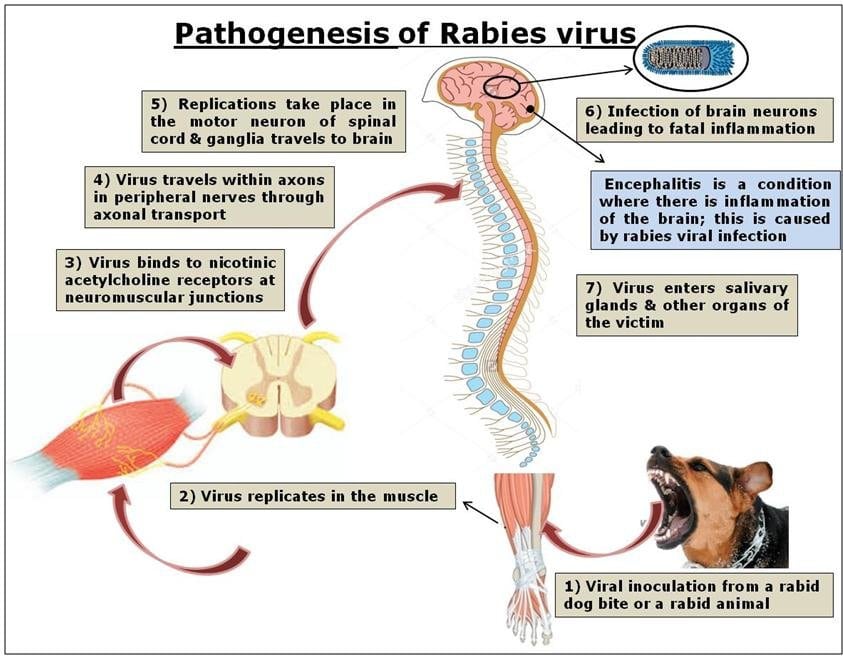
Before receiving the rabies vaccine, let your doctor if you’ve ever had a serious allergic reaction to a dose of rabies vaccine. You should also tell your doctor if you have any severe allergies, or if you have a weakened immune system due to a chronic condition or use of certain medication (such as steroids).
Frequently Asked Questions
Do I need rabies treatment if an infected animal licks me?
Probably not, based on updated guidelines for rabies treatment released by the World Health Organization (WHO) in 2018. The guidelines identify three categories of rabies exposure. The first category is defined as “touching or feeding animals, licks on intact skin,” but post-exposure prophylaxis (PEP) is recommended only for category 2 and category 3 exposure.
What are the side effects of rabies treatment?
The vaccine given to prevent rabies after exposure to the virus is safe and effective for most people, with side effects that are similar to those of any vaccine:
- Symptoms at the injection site such as soreness, redness, swelling, or itching
- Systemic side effects including headache, nausea, stomach pain, muscle aches, or dizziness
After booster shots, some people develop hives, joint pain, or fever. There are few known long-term complications associated with the rabies vaccine, although there have been rare reports of Guillain-Barre syndrome following the vaccine.
There are few known long-term complications associated with the rabies vaccine, although there have been rare reports of Guillain-Barre syndrome following the vaccine.
How can I protect my family and my pets from rabies?
The American Veterinary Medication Association recommends parents and pets:
- Have all pets that are mammals, including ferrets, livestock, and horses, vaccinated.
- Keep cats and ferrets inside; do not allow pets that go outside to run free.
- Don’t keep wild animals as pets.
- Never leave food, including pet food, outside, which can attract rabid animals.
- Bat-proof houses, garages, and other structures.
- Teach children to steer clear of animals they don’t know, even those that seem tame. Rabies doesn’t always cause animals to act strangely.
Rabies Doctor Discussion Guide
Get our printable guide for your next doctor’s appointment to help you ask the right questions.
Email the Guide
Send to yourself or a loved one.
Sign Up
This Doctor Discussion Guide has been sent to {{form.email}}.
There was an error. Please try again.
Rabies
Rabies is a vaccine-preventable, zoonotic, viral disease. Once clinical symptoms appear, rabies is virtually 100% fatal. In up to 99% of cases, domestic dogs are responsible for rabies virus transmission to humans. Yet, rabies can affect both domestic
and wild animals. It is spread to people and animals through bites or scratches, usually via saliva.
Rabies is present on all continents, except Antarctica, with over 95% of human deaths occurring in the Asia and Africa regions. Rabies is one of the Neglected Tropical Diseases (NTD) that predominantly affects poor and vulnerable populations who
live in remote rural locations. Approximately 80% of human cases occur in rural areas. Although effective human vaccines and immunoglobulins exist for rabies, they are not readily available or accessible to those in need. Globally, rabies deaths are
Globally, rabies deaths are
rarely reported and children between the ages of 5–14 years are frequent victims. Managing a rabies exposure, where the average cost of rabies post-exposure prophylaxis (PEP) is currently estimated at an average of US$ 108 can be a catastrophic
financial burden on affected families whose average daily income may be as low as US$ 1–2 per person1
Every year, more than 29 million people worldwide receive a post-bite vaccination. This is estimated to prevent hundreds of thousands of rabies deaths annually. Globally, the economic burden of dog-mediated rabies is estimated at US$ 8.6 billion per year.
Prevention
Eliminating rabies in dogs
Rabies is a vaccine-preventable disease. Vaccinating dogs is the most cost-effective strategy for preventing rabies in people. Dog vaccination reduces deaths attributable to dog-mediated rabies and the need for PEP as a part of dog bite patient care.
Awareness on rabies and preventing dog bites
Education on dog behaviour and bite prevention for both children and adults is an essential extension of a rabies vaccination programme and can decrease both the incidence of human rabies and the financial burden of treating dog bites. Increasing
Increasing
awareness of rabies prevention and control in communities includes education and information on responsible pet ownership, how to prevent dog bites, and immediate care measures after a bite. Engagement and ownership of the programme at the community
level increases reach and uptake of key messages.
Immunization of people
The same vaccine is used to immunize people after an exposure (see PEP) or before exposure to rabies (less common). Pre-exposure immunization is recommended for people in certain high-risk occupations such as laboratory workers handling live rabies
and rabies-related (lyssavirus) viruses; and people (such as animal disease control staff and wildlife rangers) whose professional or personal activities might bring them into direct contact with bats, carnivores, or other mammals that may be
infected.
Pre-exposure immunization might be indicated also for outdoor travellers to and expatriates living in remote areas with a high rabies exposure risk and limited local access to rabies biologics.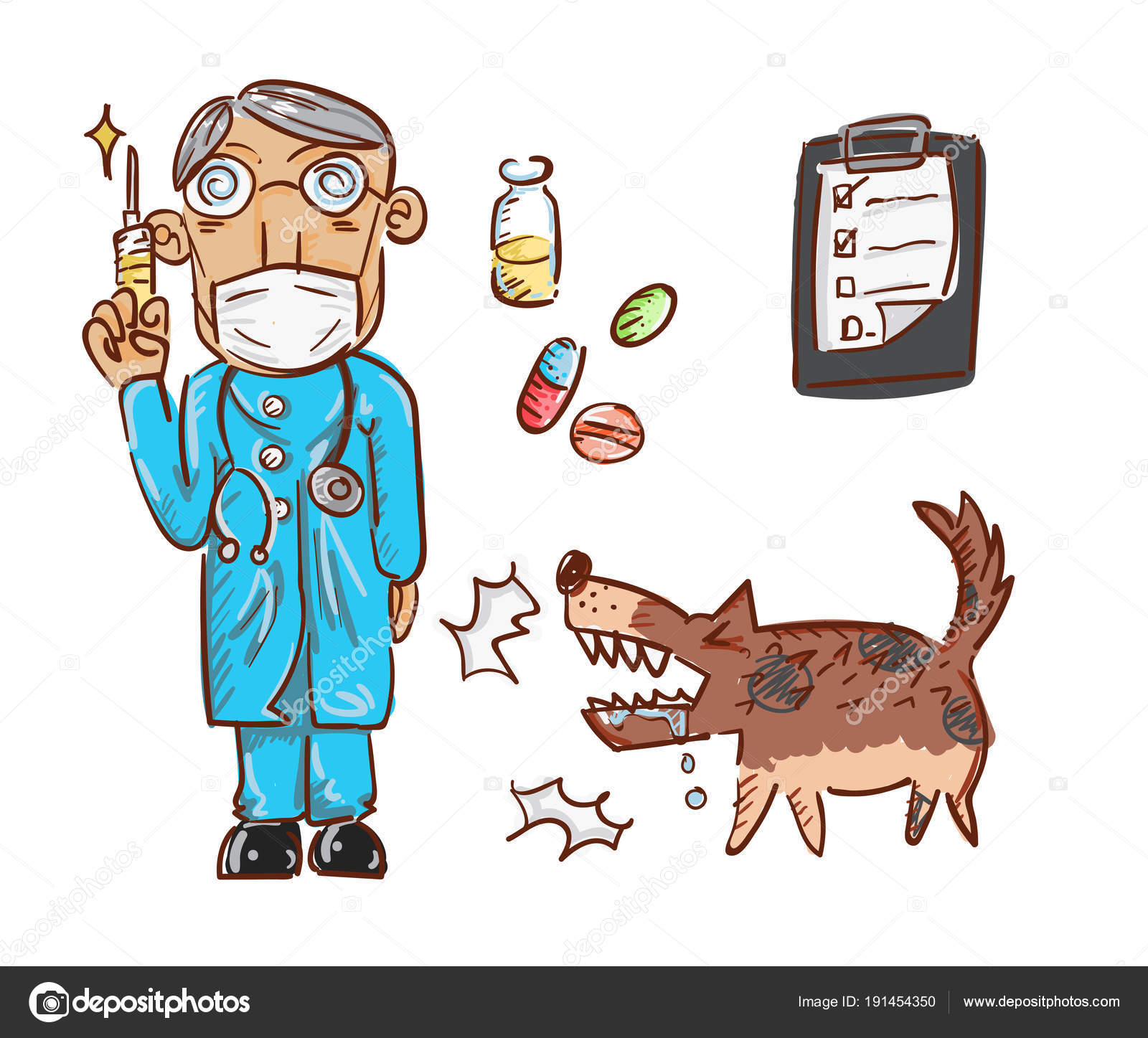 Finally, immunization should also be considered for children
Finally, immunization should also be considered for children
living in, or visiting such areas. As they play with animals, they may receive more severe bites, or may not report bites.
Symptoms
The incubation period for rabies is typically 2–3 months but may vary from 1 week to 1 year, dependent upon factors such as the location of virus entry and viral load. Initial symptoms of rabies include a fever with pain and unusual or unexplained
tingling, pricking, or burning sensation (paraesthesia) at the wound site. As the virus spreads to the central nervous system, progressive and fatal inflammation of the brain and spinal cord develops.
There are two forms of the disease:
- Furious rabies results in signs of hyperactivity, excitable behaviour, hydrophobia (fear of water) and sometimes aerophobia (fear of drafts or of fresh air). Death occurs after a few days due to cardio-respiratory arrest.
- Paralytic rabies accounts for about 20% of the total number of human cases.
 This form of rabies runs a less dramatic and usually longer course than the furious form. Muscles gradually become paralysed, starting at the site of the bite or scratch. A coma slowly develops, and eventually death occurs. The paralytic form of rabies is often misdiagnosed, contributing to the under-reporting of the disease.
This form of rabies runs a less dramatic and usually longer course than the furious form. Muscles gradually become paralysed, starting at the site of the bite or scratch. A coma slowly develops, and eventually death occurs. The paralytic form of rabies is often misdiagnosed, contributing to the under-reporting of the disease.
Diagnosis
Current diagnostic tools are not suitable for detecting rabies infection before the onset of clinical disease, and unless the rabies-specific signs of hydrophobia or aerophobia are present, clinical diagnosis may be difficult. Human rabies can be
confirmed intra-vitam and post mortem by various diagnostic techniques that detect whole viruses, viral antigens, or nucleic acids in infected tissues (brain, skin or saliva)2
Transmission
People are usually infected following a deep bite or scratch from an animal with rabies, and transmission to humans by rabid dogs accounts for up to 99% of cases.
In the Americas, bats are now the major source of human rabies deaths as dog-mediated transmission has mostly been broken in this region.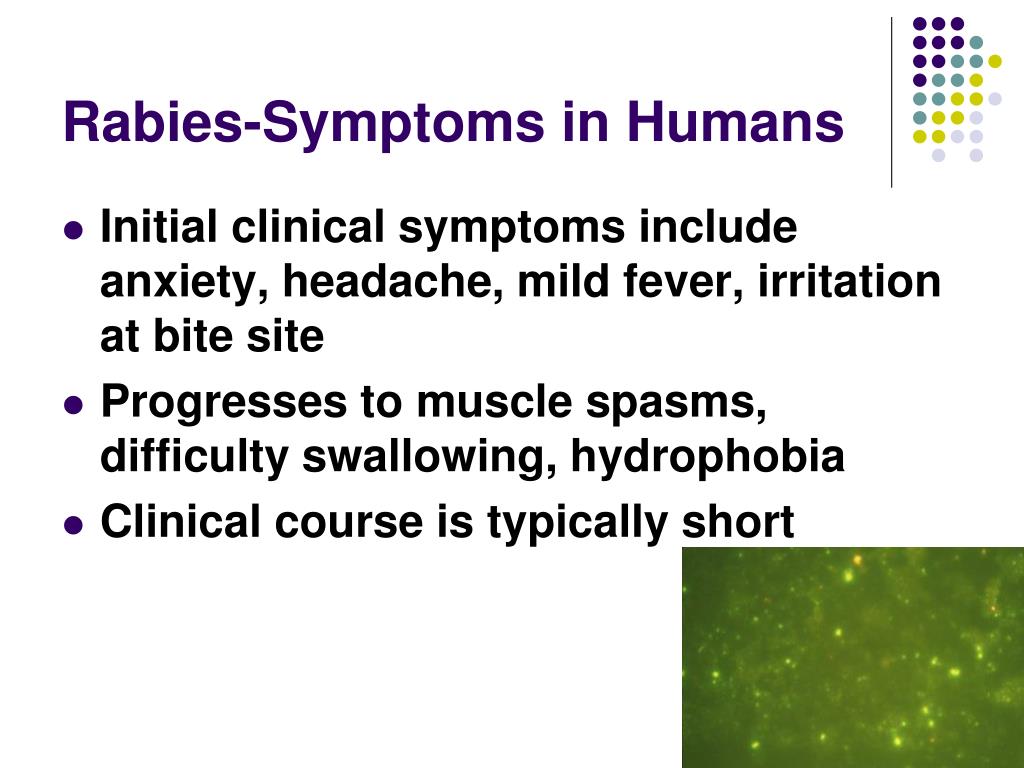 Bat rabies is also an emerging public health threat in Australia and Western Europe. Human deaths following exposure
Bat rabies is also an emerging public health threat in Australia and Western Europe. Human deaths following exposure
to foxes, raccoons, skunks, jackals, mongooses and other wild carnivore host species are very rare, and bites from rodents are not known to transmit rabies.
Transmission can also occur if saliva of infected animals comes into direct contact with human mucosa or fresh skin wounds. Contraction of rabies through inhalation of virus-containing aerosols or through transplantation of infected organs is described,
but extremely rare. Human-to-human transmission through bites or saliva is theoretically possible but has never been confirmed. The same applies for transmission to humans via consumption of raw meat or milk of infected animals.
Post-exposure prophylaxis (PEP)
Post-exposure prophylaxis (PEP) is the immediate treatment of a bite victim after rabies exposure. This prevents virus entry into the central nervous system, which results in imminent death.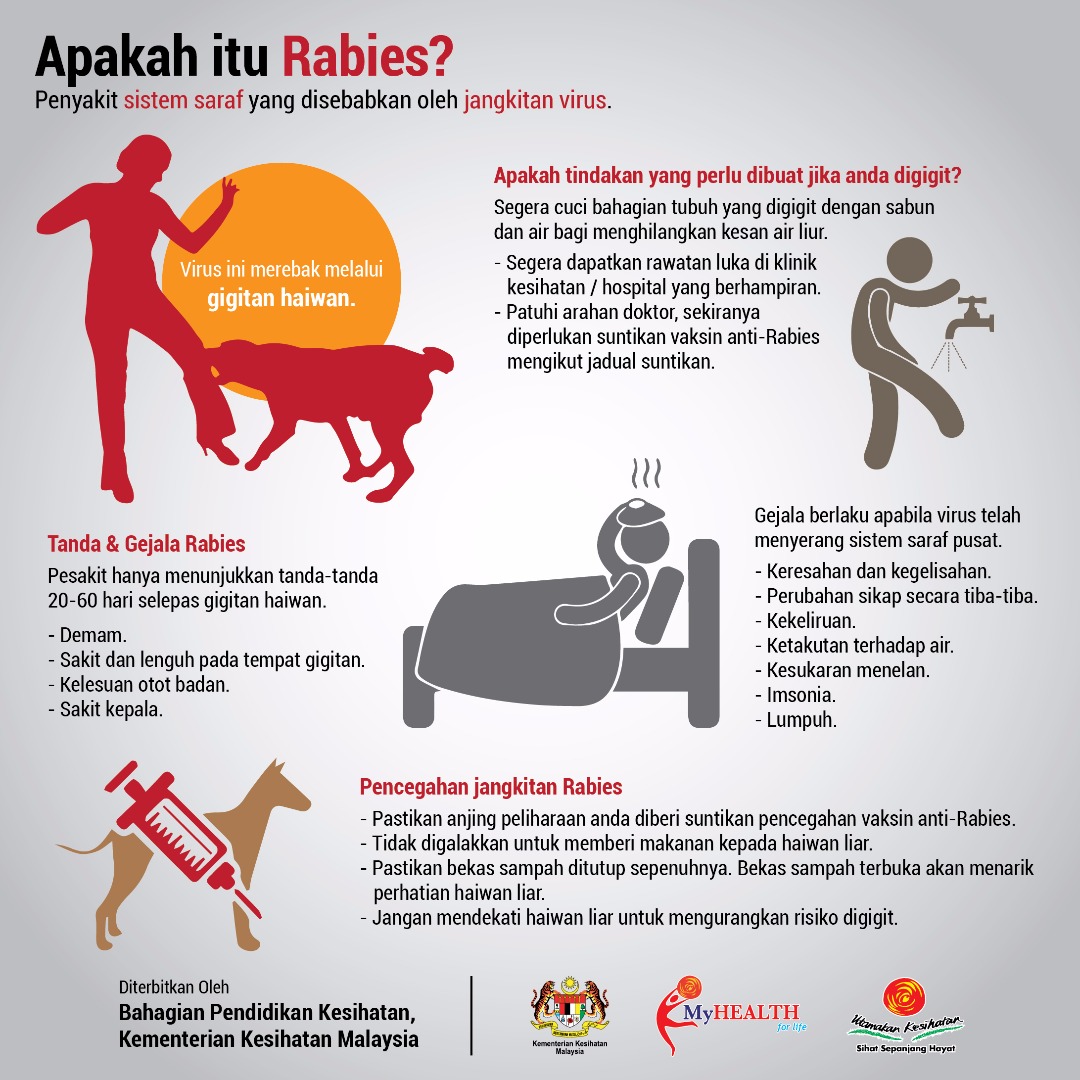 PEP consists of:
PEP consists of:
- Extensive washing and local treatment of the bite wound or scratch as soon as possible after a suspected exposure;
- a course of potent and effective rabies vaccine that meets WHO standards; and
- the administration of rabies immunoglobulin (RIG), if indicated.
Starting the treatment soon after an exposure to rabies virus can effectively prevent the onset of symptoms and death.
Extensive wound washing
This first-aid measure includes immediate and thorough flushing and washing of the wound for a minimum of 15 minutes with soap and water, detergent, povidone iodine or other substances that remove and kill the rabies virus.
Exposure risk and indications for PEP
Depending on the severity of the contact with the suspected rabid animal, administration of a full PEP course is recommended as follows:
| Table: Categories of contact and recommended post-exposure prophylaxis (PEP) | |||||
| Categories of contact with suspect rabid animal | Post-exposure prophylaxis measures | ||||
|---|---|---|---|---|---|
| Category I – touching or feeding animals, animal licks on intact skin (no exposure) | Washing of exposed skin surfaces, no PEP | ||||
| Category II – nibbling of uncovered skin, minor scratches or abrasions without bleeding (exposure) | Wound washing and immediate vaccination | ||||
| Category III – single or multiple transdermal bites or scratches, contamination of mucous membrane or broken skin with saliva from animal licks, exposures due to direct contact with bats (severe exposure) | Wound washing, immediate vaccination and administration of rabies immunoglobulin | ||||
All category II and III exposures assessed as carrying a risk of developing rabies require PEP.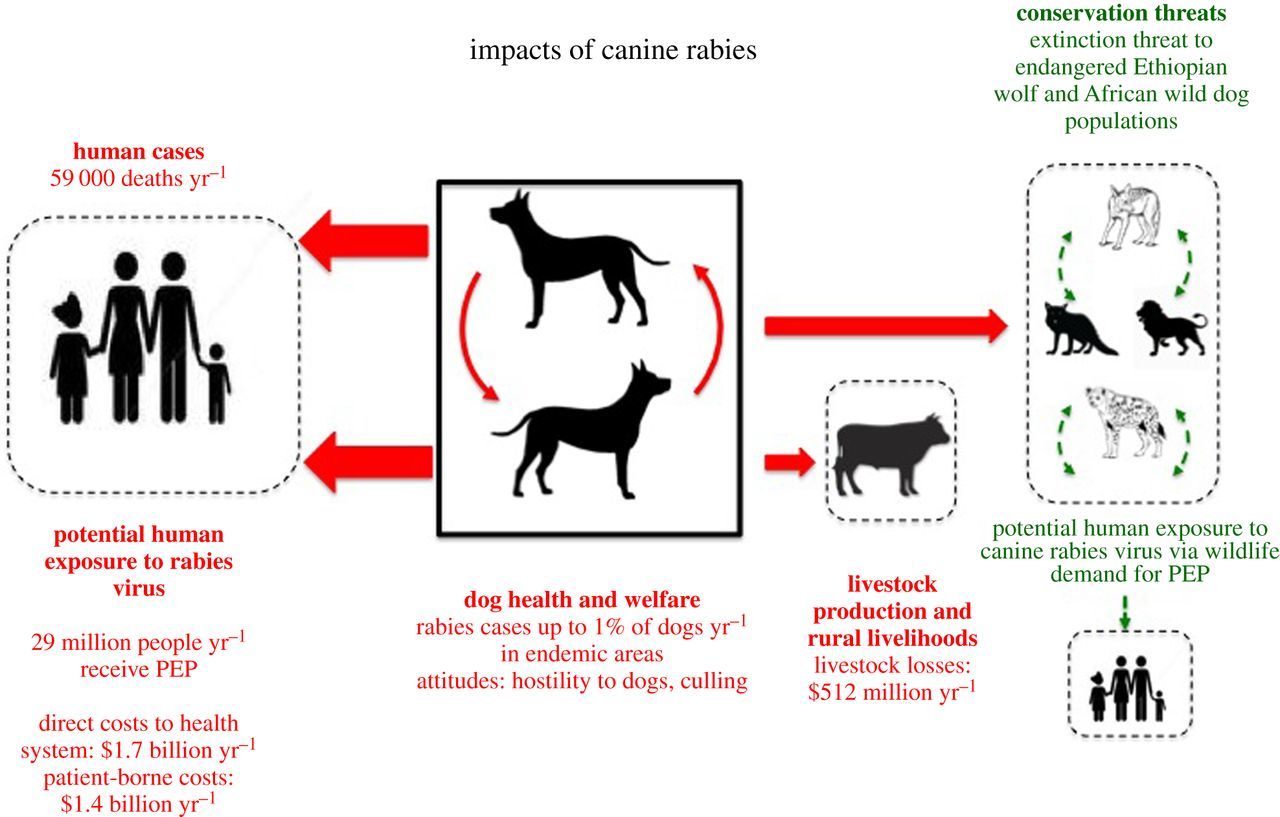
This risk is increased if:
- the biting mammal is a known rabies reservoir or vector species
- the exposure occurs in a geographical area where rabies is still present
- the animal looks sick or displays abnormal behaviour
- a wound or mucous membrane was contaminated by the animal’s saliva
- the bite was unprovoked
- the animal has not been vaccinated.
The vaccination status of the suspect animal should not be the deciding factor when considering to initiate PEP or not when the vaccination status of the animal is questionable. This can be the case if dog vaccination programmes are not being sufficiently
regulated or followed out of lack of resources or low priority.
WHO continues to promote human rabies prevention through the elimination of rabies in dogs, dog bite prevention strategies, and more widespread use of the intradermal route for PEP which reduces volume and therefore the cost of cell-cultured vaccine
by 60% to 80%.
Integrated bite case management
If possible, the veterinary services should be alerted, the biting animal identified, removed from the community and either quarantined for observation (for healthy dogs and cats) or submitted for immediate laboratory examination (dead or euthanized
animals showing clinical signs of rabies). PEP must be continued during the 10-day observation period or while awaiting laboratory results. Treatment may be discontinued if the animal is proven to be free of rabies. If a suspect animal cannot
be captured and tested, then a full course of PEP should be completed. Joint contact tracing by veterinary and public health services is encouraged to identify additional suspected rabid animals and human bite victims, with the goal to apply preventive
measures accordingly.
WHO response
Rabies is included in WHO’s new 2021-2030 road map. As a zoonotic disease, it requires close cross-sectoral coordination at the national, regional and global levels.
- WHO, FAO (Food and Agriculture Organization) and OIE (World Organisation for Animal Health), have prioritized rabies under a One Health approach and have launched he ‘United Against Rabies Forum’ (UAR), a multi-stakeholder platform.
- UAR advocates and prioritizes investments in rabies control and coordinates the global rabies-elimination efforts to achieve zero human deaths from dog-mediated rabies by 2030Progress in rabies elimination provides an indicator of One Health operationalization
and strengthened human and animal health systems. - Rabies can significantly contribute to building of capacity outside of the health structures and of a siloed notion of health, and demonstrate that One Health can truly provide a framework in which cross-cutting benefits can be realised and shared.
- WHO works with partners to guide and support countries as they develop and implement their national rabies elimination plans
- WHO regularly updates and disseminates technical guidance on rabies 3, for example on epidemiology, surveillance, diagnostics, vaccines, safe and cost-effective immunization4, control and prevention strategies for human
and animal rabies, operational programme implementation5 ;and palliative care for human rabies patients - On the path towards rabies elimination countries can request WHO validation of achieving zero human deaths from dog-mediated rabies3; and seek OIE endorsement of their dog rabies control programmes and self-declare freedom from dog
rabies
6; - Mexico was the first country to have been validated by WHO in 2019 for eliminating human deaths from dog-mediated rabies
- Inclusion of rabies biologics into countries list of essential medicines and advocating for increased access of poor and rural populations to PEP is a WHO priority and strengthens the global movement towards achieving Universal Health Coverage
- In 2019 Gavi included human rabies vaccines in its vaccine investment strategy 2021-2025 which will support scaling up rabies PEP in Gavi eligible countries.
 Its roll out has been disrupted due to Covid-19 WHO will continue to advise on best strategies
Its roll out has been disrupted due to Covid-19 WHO will continue to advise on best strategies
and practices for its roll out to countries requesting rabies vaccine. - Monitoring of rabies programmes and disease surveillance are needed to measure impact and for increasing awareness and advocacy.
The 2030 NTD Roadmap is a guiding document for the global response to NTDs over the next decade and includes regional, progressive targets for rabies elimination7
The key towards sustaining and expanding the rabies programmes to adjacent geographies has been to start small, catalyse local rabies programmes through stimulus packages, demonstrate success and cost-effectiveness, and ensure the engagement of governments
and affected communities.
Rabies elimination needs adequate and long-term investments. Showcasing local success and raising awareness on rabies have been proven effective to gain and maintain political will.
————————————–
Rabies virus: can we treat the untreatable?
Posted on June 25, 2019 by Laura Cox
Every year, an estimated 59,000 people die from rabies.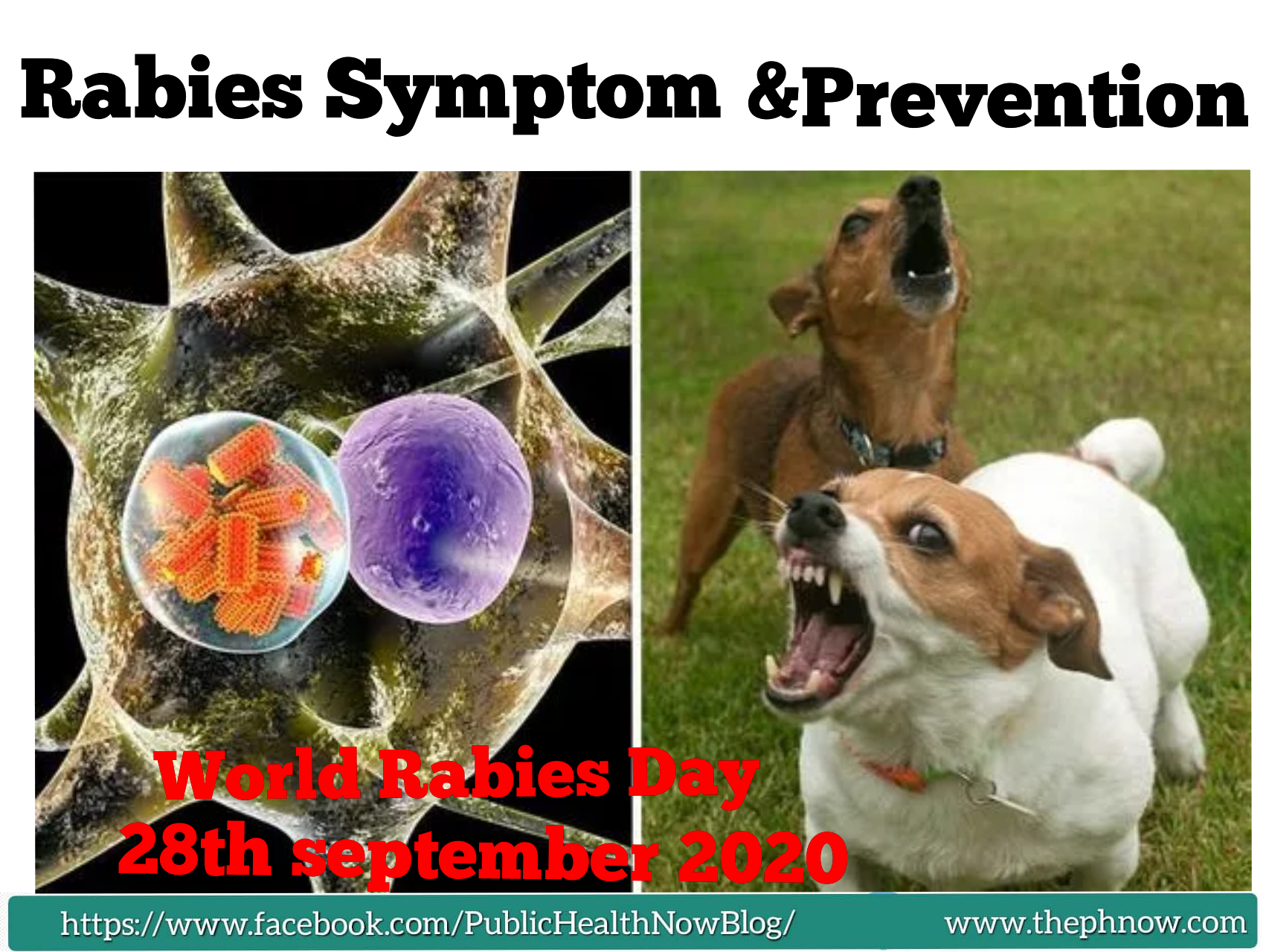 Usually contracted following a bite from an infected animal, rabies is almost always fatal in people who have not been vaccinated. Once symptoms of appear, there is little-to-no hope for the infected individual, with no treatment options currently available.
Usually contracted following a bite from an infected animal, rabies is almost always fatal in people who have not been vaccinated. Once symptoms of appear, there is little-to-no hope for the infected individual, with no treatment options currently available.
Rabies is a viral disease that spreads to humans from animals and infects the nerves and brain. The disease is caused by lyssaviruses; a genus of viruses in the Rhabdoviridae family. The lyssavirus most important to human health is Rabies virus (RABV), which is still a major concern to human health around the world. Only six people are known to have survived from rabies infection after symptoms appear, making it one of the world’s deadliest viruses.
© iStock/Ivan Kuzmin
The virus is spread through saliva and is usually contracted following a bite or scratch from an infected dog. Other animal carriers include bats, wild canines and cats. The virus moves through the nervous system, travelling from the peripheral nerves, up the spinal cord and to the brain. Within 3-12 weeks of exposure, symptoms develop including fever, headache and anxiety. Within days, these symptoms develop to more severe signs, including aggressive behaviour, frothing at the mouth, hallucinations and paralysis. Once the virus reaches the brain, it causes overstimulation of nerve receptors – known as excitotoxicity – killing brain cells at an alarming rate.
The virus moves through the nervous system, travelling from the peripheral nerves, up the spinal cord and to the brain. Within 3-12 weeks of exposure, symptoms develop including fever, headache and anxiety. Within days, these symptoms develop to more severe signs, including aggressive behaviour, frothing at the mouth, hallucinations and paralysis. Once the virus reaches the brain, it causes overstimulation of nerve receptors – known as excitotoxicity – killing brain cells at an alarming rate.
Of course, the virus does not immediately enter a nerve following a bite or scratch from an infected animal and must replicate in other cell types until it can come into contact with, and infect, a nerve cell. During this time, there are no symptoms and the virus is at its most vulnerable to clearance by the immune system. It is during this time that the post-exposure vaccine can be administered with an excellent success rate.
Protection and prevention:
© Wikimedia Commons
Louis Pasteur
Vaccines to protect against rabies infection have been around for a long time, with the first rabies vaccine developed by Louis Pasteur. In 1885, after five years of work developing a vaccine to protect dogs from the disease, Pasteur administered his vaccine on a nine-year-old boy who had been bitten by a rabid dog. The vaccine worked, and rapidly became a life-saving post-exposure treatment for the disease.
In 1885, after five years of work developing a vaccine to protect dogs from the disease, Pasteur administered his vaccine on a nine-year-old boy who had been bitten by a rabid dog. The vaccine worked, and rapidly became a life-saving post-exposure treatment for the disease.
Over the following years, research into the vaccine continues, and in 1908 an inactivated vaccine was developed and approved. Rabies vaccines are now given around the world, and the World Health Organization estimates that the vaccine prevents over 270,000 deaths each year. Unfortunately, the vaccine can only provide protect against the disease before symptoms emerge, meaning people who are unknowingly infected have little chance of survival.
The Milwaukee Protocol:
In 2004, a fifteen-year-old girl called Jeanna was bitten on the finger by a bat. Just over a month later, Jeanna started showing symptoms of infection, including slurred speech, fever and vomiting. Luckily for Jeanna, doctors at the Children’s Hospital of Wisconsin had an idea of how to protect the brain before the virus can enter it: a coma.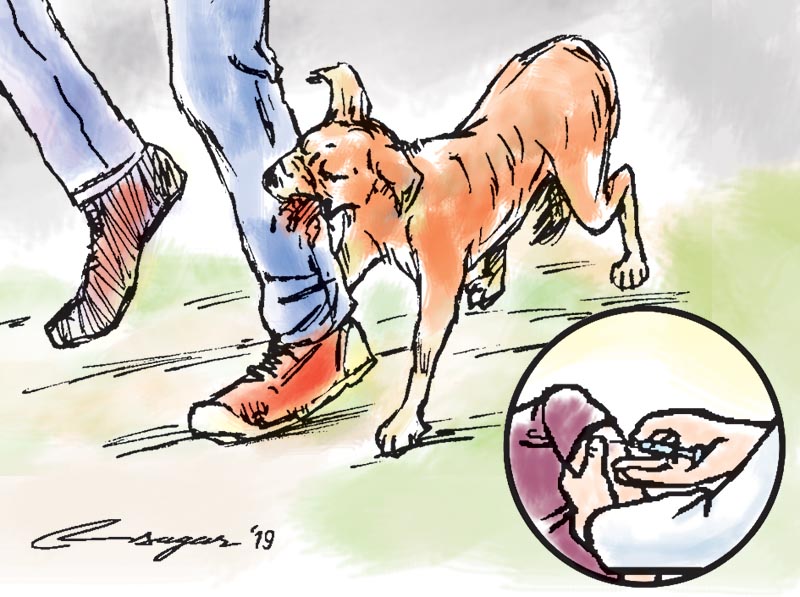 To give her immune system time to fight off the virus, they induced a coma and provided a number of antiviral drugs and ketamine, a procedure they named as The Milwaukee Protocol. Within days they found antibodies against the virus in the spinal fluid – the infection cleared and Jeanna began to recover. Finally, there was hope for a cure!
To give her immune system time to fight off the virus, they induced a coma and provided a number of antiviral drugs and ketamine, a procedure they named as The Milwaukee Protocol. Within days they found antibodies against the virus in the spinal fluid – the infection cleared and Jeanna began to recover. Finally, there was hope for a cure!
The procedure that showed so much promise, with overwhelming success on the first attempt unfortunately did not live up to expectations. The Protocol has been tried over 50 times around the world, but only a handful of patients have survived, meaning this treatment is not recommended and remains highly controversial.
The challenges:
© iStock/pixologicstudio
So why is rabies so difficult to treat? Viral infections can usually be treated using anti-viral drugs, which inhibit virus development. Rabies virus uses a myriad of strategies to avoid the immune system and hide from antiviral drugs, even using the blood brain barrier to protect itself once it has entered the brain. The blood brain barrier is a membrane that prevents cells and large molecules from entering the brain. During infection of the brain, the permeability of the barrier can increase, allowing immune cells and antibodies through to help clear the infection. However, during infection with rabies virus, the blood brain barrier locks down, meaning nothing can get through, even antiviral drugs.
The blood brain barrier is a membrane that prevents cells and large molecules from entering the brain. During infection of the brain, the permeability of the barrier can increase, allowing immune cells and antibodies through to help clear the infection. However, during infection with rabies virus, the blood brain barrier locks down, meaning nothing can get through, even antiviral drugs.
The virus goes even further to continue infection and manipulates the immune system to destroy itself instead of targeting infected nerve cells. This manipulation of host responses has made finding strategies to treat rabies following infection difficult for researchers, with many potential antivirals showing promising results in in vitro, laboratory tests being unsuccessful in more complex, in vivo systems.
Looking forward:
A recent review published in the Journal of General Virology, authored by researchers from the Animal and Plant Health Agency (APHA), St George’s, University of London and the University of West Sussex discusses the ongoing research into finding treatment for the virus and the efforts being made to develop new vaccines.
Rabies : OSH Answers
Workers who have contact with animals must know how to deal with rabid animals and how to protect themselves from the rabies virus.
With the development of an oral vaccine for animals, vaccinating of local wildlife has become a common way to manage outbreaks.
Dealing with rabid animals
Do not approach or kill an animal suspected of having rabies except to defend yourself, other people, or other animals. If an animal must be killed, try to avoid damaging its head. An undamaged brain is important for a quick laboratory diagnosis. If an animal suspected of having rabies is responsive or manageable, keep it alive and away from other animals or people. Do not touch it with bare hands. If an animal is unmanageable and dangerous and cannot be restrained or killed, observe its movements and seek help from qualified experts as soon as possible. If you must handle the animal or carcass, wear protective gloves to prevent infectious material from having contact with cuts or rashes on the skin. Also wear protective masks and goggles to protect against infectious aerosols. When there is a need for personal protective equipment (PPE), then there should be a PPE program in place where you work.
Also wear protective masks and goggles to protect against infectious aerosols. When there is a need for personal protective equipment (PPE), then there should be a PPE program in place where you work.
Responsibility for the management of rabies is shared by the public, the veterinary profession and all levels of government. Canadian federal regulations requires all pets, livestock or wild animals that may be rabid, or had contact with a potentially rabid animal, to be reported to a veterinarian, veterinary clinic, local medical health officer or public health authority immediately. These professionals or agencies will in turn report the incident to the Canadian Food Inspection Agency (CFIA).
Protection for workers who have had contact with the rabies virus
Workers who have come into contact with saliva, body fluids, or tissue of animals suspected of having rabies must take the following steps without delay.
Immediately clean and flush their skin (even if there is no obvious bite or scratch) with water for several minutes. Cleaning will help wash out the virus. If available, use soap or detergent to help kill the virus. Washing the area or wound is probably the most effective procedure in the prevention of rabies. While cleaning is being done, shield the eyes, nose, and mouth from spray. After cleaning, follow by 70% ethanol or an iodine containing solution when available.
Cleaning will help wash out the virus. If available, use soap or detergent to help kill the virus. Washing the area or wound is probably the most effective procedure in the prevention of rabies. While cleaning is being done, shield the eyes, nose, and mouth from spray. After cleaning, follow by 70% ethanol or an iodine containing solution when available.
Remove any clothing that may be contaminated, place it in a plastic bag properly labelled and wash it promptly and separately from other clothing. Get medical advice as soon as possible.
Contact the police, your local health unit and district veterinarian or local office of the Canadian Food Inspection Agency. If possible, provide the following information:
- the name and address of all persons attacked or exposed to the animal’s saliva, body fluids or tissues
- the time and place of the incident
- any other information to help find and identify the offending animal
Laboratory precautions for rabies
Biosafety containment level 3 is recommended when working with the rabies virus (includes full coverage protective clothing, front gowns with tight fitting wrists, gloves, respiratory protection, and eye protection (if risk of splashes)).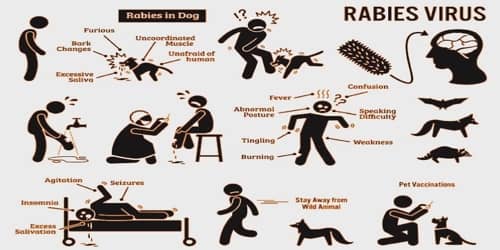 Additional precautions may be necessary. Please see the Rabies Virus – Pathogen Safety Data Sheet (2011) from the Public Health Agency of Canada for more information.
Additional precautions may be necessary. Please see the Rabies Virus – Pathogen Safety Data Sheet (2011) from the Public Health Agency of Canada for more information.
What Happens When You Get Rabies?
Most people have an understandable fear of contracting rabies. This doesn’t mean all the ideas and anxiety toward rabies is founded. In fact, there are many misconceptions about what the virus actually is.
Rabies is a virus that’s transmitted from animals to humans through the the genus Lyssavirus, according to the World Health Organization.
There is a myth that rabies is usually transferred through rodents, but according to the WHO, 95 percent of deaths transfer via dogs.
The virus can spread from infected saliva entering through an open wound on the skin. But, the virus cannot affect a person with unpunctured skin. Even if bit, rabies only spreads when the skin is opened in some way.
Once infected an individual can incubate rabies without side effects for up to three months.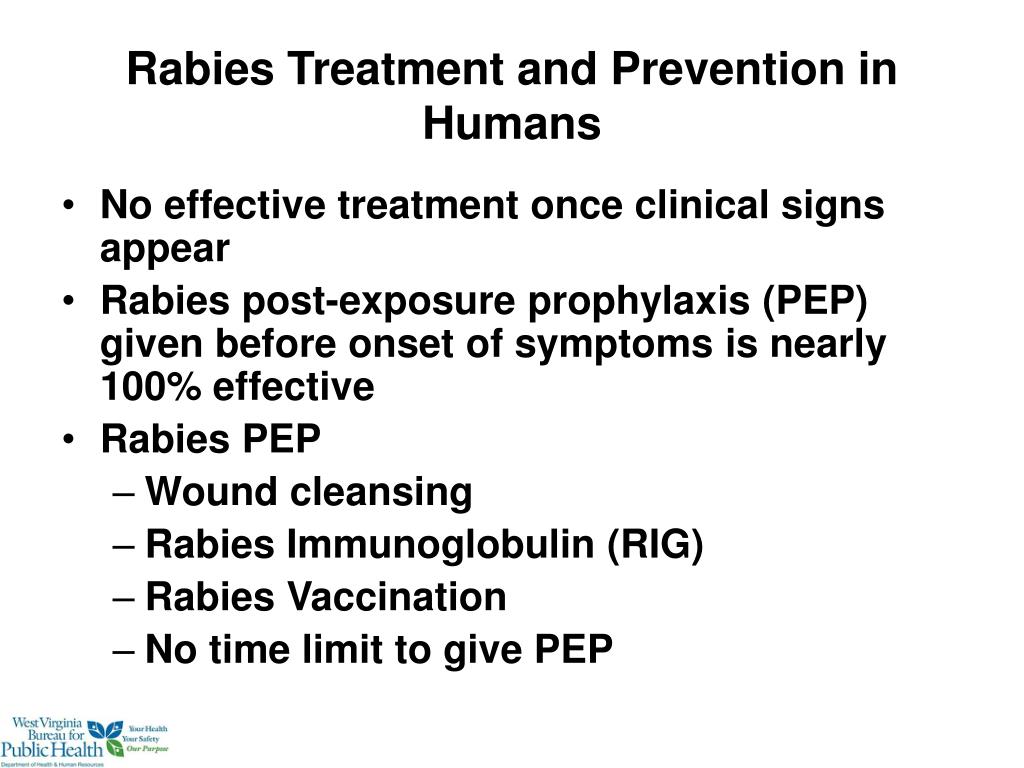 Once infected, the virus itself can last for up to a year. This starts with the original symptoms like fever, pain, and unusual tingling or a burning sensation around the open wound.
Once infected, the virus itself can last for up to a year. This starts with the original symptoms like fever, pain, and unusual tingling or a burning sensation around the open wound.
Diagnosis can often be a problem around this stage, as some of the symptoms present like the flu. This can lead to a misdiagnosis for the common virus.
The next set of symptoms get far more severe, causing trouble with the central nervous system. Any problems with this part of the body can cause inflammation in the spinal cord and brain, which could ultimately lead to death.
Once these symptoms appear, an individual’s chances of survival dramatically decrease. According to the Center for Disease Control, there have only been ten reported cases of individuals surviving this stage of the virus. Of those that survived, eight had some form of rabies vaccination in the past.
The type of rabies you contract also has an effect on the symptoms.
There are two varieties for rabies: furious and paralytic.
Furious is the most common form found in humans, accounting for 80 percent of human cases. This strand of rabies can cause hyperactivity, hydrophobia, and aerophobia. After a few days, the symptoms can cause the individual infected to go into a coma and later die.
The paralytic form of rabies is usually less harmful, but can last longer. This strand of rabies causes muscle weakness and even paralysis. Death is usually caused by respiratory failure.
Rabies can be deadly without treatment, but there is a vaccine available. But, in areas where rabies is prevalent, a lack of access to healthcare prevent locals from getting the vaccine.
According to the CDC, there are only 1-2 cases of rabies in the United States per year. This is due to the large effort to vaccinate and prevent the virus. The CDC even offers a chance to view if there has been a rabies case in your area.
Not only are mass vaccinations being used to eliminate rabies in high-risk areas, but many countries require dogs receive the vaccine as well.
The WHO suggests different treatment depending on what kind of exposure and individual has with rabies. Unsure if you need the rabies vaccine depending on where you’re going? Passport Health can help! Give us a call at or book an appointment online now.
Do you have any other questions about the rabies process? Let us know in the comments, or via Facebook and Twitter.
Written for Passport Health by Kaitlyn Luckow. Kaitlyn is a freelance writer, photographer and English teacher in Milwaukee. She has a passion for capturing and writing other people’s stories. You can find her at sayhellostory.com.
Can Rabies be Cured After Symptoms Occur?
Cure for rabies in humans involves an injection of rabies vaccine, it is meant to be given as a deterrent against the rabies virus.
Rabies is an infectious disease that can be transmitted from animals to humans caused by the rabies virus. This disease is usually transmitted through contact with the animal’s saliva when the infected animals bite or scratch someone. In many cases, dogs are mostly the cause of rabies transmission. However, animals such as cats, bats, raccoons, and monkeys may also carry this virus and transmit it to humans. People with a high risk of having rabies are suggested to be vaccinated, such as animal farmers, veterinarians, and other professions that make direct contact with animals. In addition, the rabies vaccine is also recommended for foreigners traveling to areas with high rabies exposure, for example, Bali.
In many cases, dogs are mostly the cause of rabies transmission. However, animals such as cats, bats, raccoons, and monkeys may also carry this virus and transmit it to humans. People with a high risk of having rabies are suggested to be vaccinated, such as animal farmers, veterinarians, and other professions that make direct contact with animals. In addition, the rabies vaccine is also recommended for foreigners traveling to areas with high rabies exposure, for example, Bali.
Further treatment should be taken if a person is bitten by an animal suspected of having rabies, an infected patient is advised to be vaccinated immediately so the virus doesn’t spread to the brain and nervous system. Rabies infection can be fatal if it’s left unchecked. If the virus reaches the brain, it will be very dangerous because, at this point, death is inevitable. Therefore, early treatment and getting rabies vaccination after infected is necessary to avoid this condition. The cure for rabies in humans still can be effective as long as the virus has not spread to the brain and nervous system.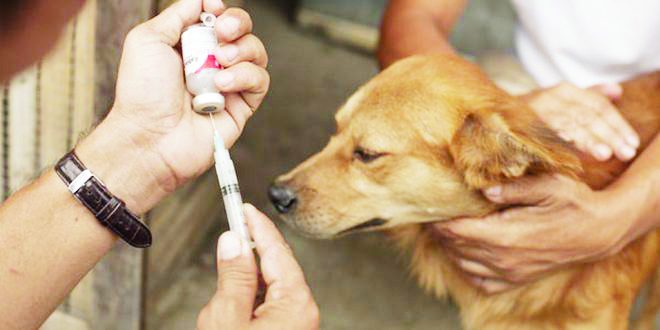 A doctor will give an indicated rabies vaccine for the infected patient to prevent worse conditions.
A doctor will give an indicated rabies vaccine for the infected patient to prevent worse conditions.
Medi-Call: Rabies Vaccination Service
Rabies Symptoms in Humans
Typically, a person will not immediately feel any symptoms. Rabies symptoms may occur around 4-12 weeks or 35-65 days after the person is bitten by an infected animal. Early symptoms of rabies are sometimes difficult for people to notice because they are similar to flu symptoms. These symptoms include fever, headache, muscle weakness, and tingling sensation (paresthesia). The time between exposure and symptoms’ appearance is called the incubation period. This period of time may vary depending on factors such as the location of the wound and the person’s immunity.
Common rabies symptoms in humans include high fever, chills, fatigue, muscle aches, difficulty swallowing, insomnia, rheumatic pain and tingling sensation in the bitten area. People infected with the rabies virus will also feel itchy, even sore in the infected wound site.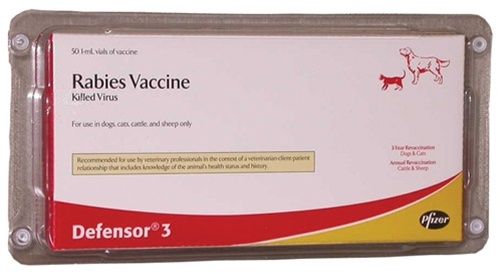 Other rabies symptoms in humans that follow are hallucinations and anxieties. People infected with the rabies virus may also experience confusion, hallucinations, and anxiety. Below are the symptoms of rabies in humans:
Other rabies symptoms in humans that follow are hallucinations and anxieties. People infected with the rabies virus may also experience confusion, hallucinations, and anxiety. Below are the symptoms of rabies in humans:
- Tingling sensation (paresthesia), Itchy in the wound site;
- Fever, headache;
- Muscle pain;
- Nausea;
- Vomiting;
- Loss of appetite;
- Sore throat, difficulty swallowing;
- Anxious;
- Insomnia;
- Hallucinations;
- Excessive drooling;
- Anger, irritability, and depression;
- Hyperactivity;
- Fear of water;
- Fear of light.
Rabies Vaccine as the Cure for Rabies in Humans
If a person got bitten by an infected animal, getting a cure for rabies in humans is highly important. Further medical treatment should be done immediately to avoid the condition from becoming fatal. The most appropriate cure for rabies in humans is by getting a rabies vaccine.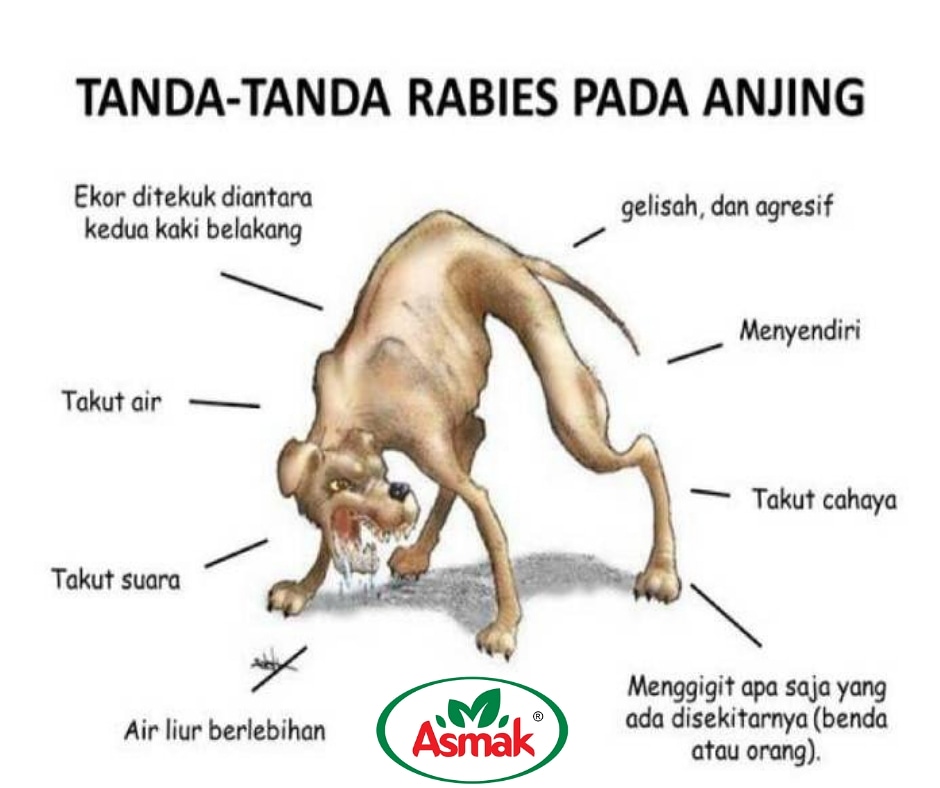 Before getting vaccinated, note that the wound site should be washed first with soap under running water for 10-15 minutes. Afterward, apply an antiseptic like povidone-iodine and go to a doctor and seek medical help to get a rabies vaccine.
Before getting vaccinated, note that the wound site should be washed first with soap under running water for 10-15 minutes. Afterward, apply an antiseptic like povidone-iodine and go to a doctor and seek medical help to get a rabies vaccine.
A doctor will give the infected person Anti-Rabies Vaccine (VAR) or Anti-Rabies Serum (SAR) as a cure for rabies in humans depending on the person’s condition. Anti-Rabies Vaccine (VAR) has a function to stimulate the rabies virus-neutralizing antibodies. The vaccine can be given for rabies prevention / before exposure (pre-exposure prophylaxis) and to people who are already infected with the virus / after exposure (post-exposure prophylaxis). On the other hand, Anti-Rabies Serum (SAR) is a passive immunization composed of Rabies Immunoglobulin. It will immediately neutralize antibodies before the immune system is ready to produce its own antibodies that occur 7-14 days after VAR is given. Usually, SAR is given once at the beginning of vaccination.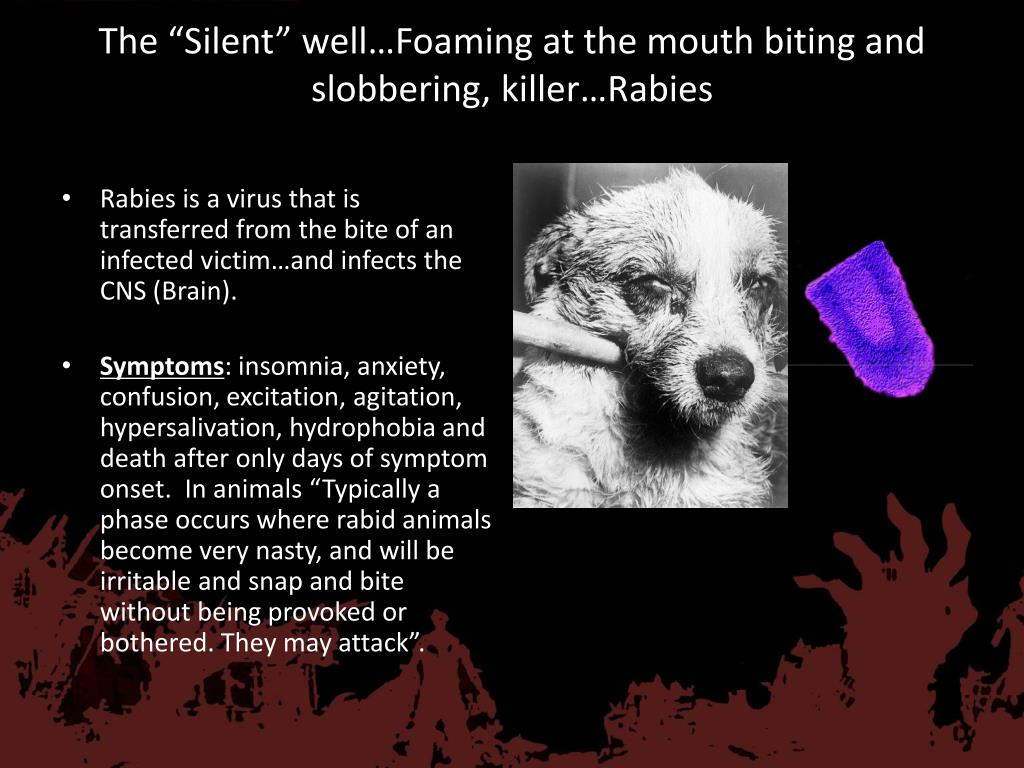 SAR injections are necessary for patients with deep/large wound, multiple wounds, wound that has to be sewn, or scratches contaminated with the animal’s saliva.
SAR injections are necessary for patients with deep/large wound, multiple wounds, wound that has to be sewn, or scratches contaminated with the animal’s saliva.
Can Rabies Be Cured After Symptoms Occur?
Rabies vaccine as the cure for rabies in humans can prevent the virus from spreading to the brain and cause death. Vaccines are best given immediately after exposure before any symptoms appear so the virus doesn’t spread throughout the body. If early symptoms already occur, rabies still can be treated with vaccination to prevent it from spreading to the brain. If clinical symptoms of rabies begin to appear, the condition is nearly always fatal and giving vaccines will be a supportive treatment. However, there’s a possibility that the virus has reached the brain and will potentially cause death. Therefore, if you got bitten by an animal suspected of carrying the rabies virus, it is suggested to immediately get vaccinated as the cure for rabies in humans before symptoms occur.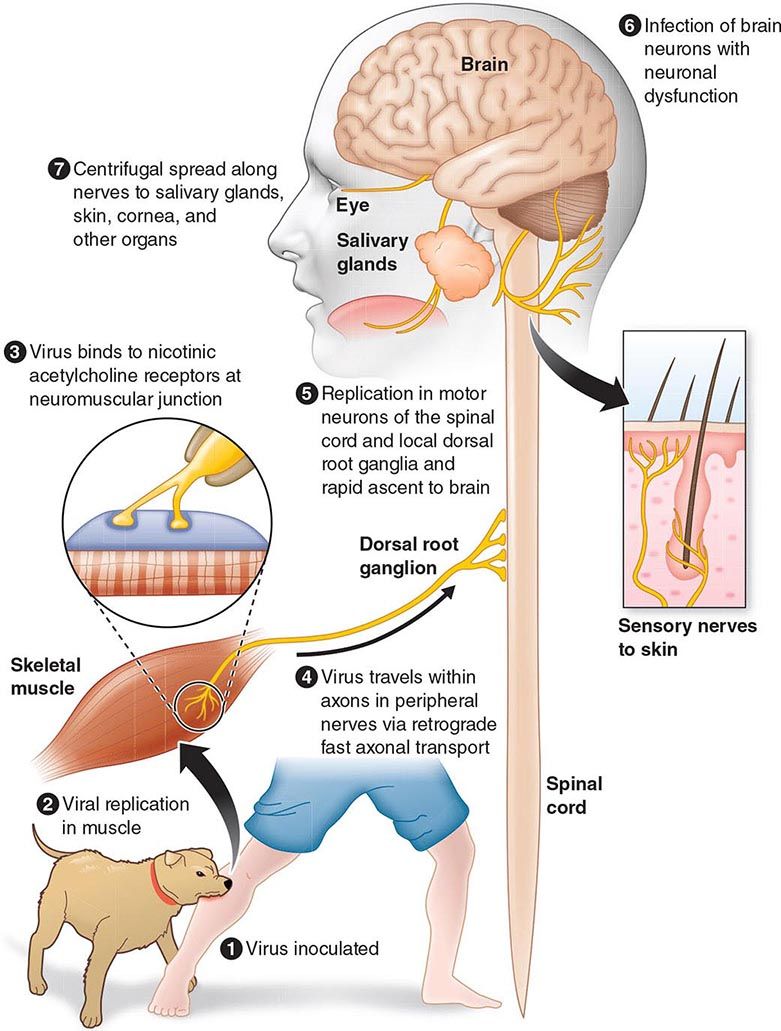
Medi-Call: Rabies Vaccination Service
Get rabies vaccination service through Medi-Call Application or contact Medi-Call Hotline at +62 81210783387. A doctor will come directly to your location and perform the vaccination.
Next Article
Treatment of Bali Belly: Learn the Symptoms and How to Cure it
What You Need To Know: Rabies and Your Pet
- Home >
- News >
- What You Need To Know: Rabies and Your Pet
We wanted to remind all our pet owners how critical it is to keep your pets up-to-date with their rabies vaccinations, and safe from this deadly disease. Many wild animals in our area can carry the rabies virus, and once an unprotected pet is bitten, there is no cure. Read this helpful FAQ on rabies, and call us to make sure your pet’s vaccine is current.
What is rabies?
Rabies is a virus that affects the nervous system of warm-blooded animals, including humans.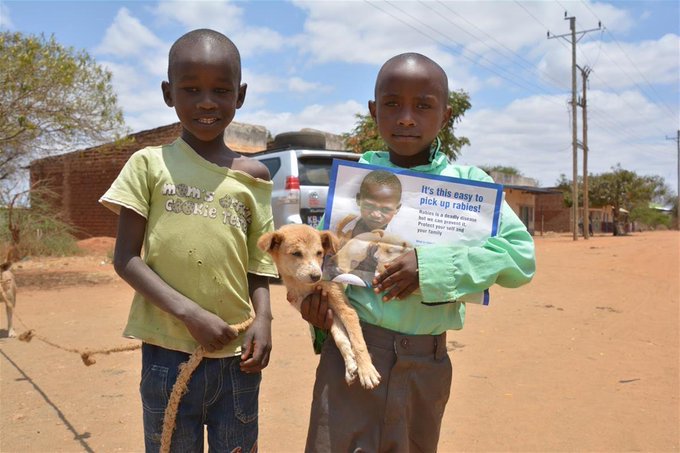 This virus is typically spread via the saliva of infected animals through bite wounds or by saliva or infected tissue that contacts open wounds and the oral cavity.
This virus is typically spread via the saliva of infected animals through bite wounds or by saliva or infected tissue that contacts open wounds and the oral cavity.
Worldwide rabies kills more than 55,000 people yearly. In the United States, the number of human deaths from rabies is 2-3 per year, although 20,000-30,000 people in the U.S. receive post-exposure rabies vaccination yearly. The majority of human cases of rabies in the world are due to contact with a rabid companion animal. Vaccination is the key component to controlling this fatal and untreatable disease.
Is rabies present in Wisconsin?
Yes. In Wisconsin, skunks and bats are the most likely animals to carry the rabies virus, although rabies also can occur in dogs, cats, foxes, raccoons and livestock.
Is rabies treatable?
No. Once symptoms of the rabies virus are present, there is no treatment. The infected person or animal will die.
Is there a test for rabies?
Testing of brain tissue can be done on a deceased animal.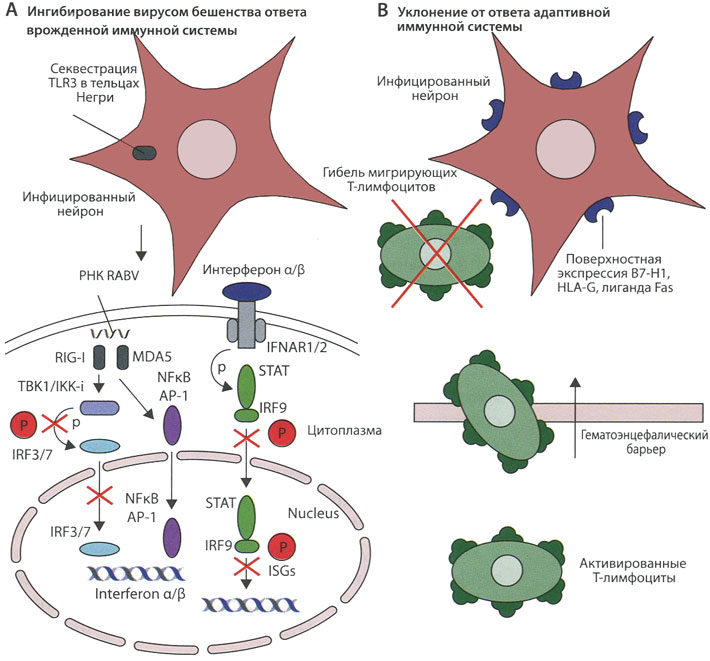 There is no test for rabies that can be done on live animals or people.
There is no test for rabies that can be done on live animals or people.
How can my pet be exposed?
There are many ways for our pets to come into contact with rabid wildlife. When a bat is infected with rabies it is more easily preyed upon and often seen during the day (which is not typical for healthy bats). Curious cats may see a struggling bat as an easy prey. Saliva from the bat may enter the cat through a bite from the bat or directly into the cat’s mouth. Dogs may come across a rabid bat or skunk while outdoors, on trails, near caves, or even in their own back yard.
But my cat never leaves the house.
I know of multiple “indoor-only” cats with exposure to a rabid bat that entered their home through a chimney flue, open window, or open door. Even indoor-only cats should be vaccinated against rabies.
Are horses and livestock affected?
Yes. Yearly vaccination against rabies is recommended for horses and livestock.
How do I protect my pet from rabies?
Consult with your veterinarian to vaccinate your pet(s) against rabies and be sure to follow recommendations regarding appropriate and timely re-vaccination. Your pet will need multiple rabies vaccinations throughout his or her life.
Your pet will need multiple rabies vaccinations throughout his or her life.
My pet had contact with a bat (skunk, sick raccoon, etc.) What should I do?
Do not touch the wild animal. Keep people, children, and other pets from being able to access the wild animal. If possible, try to safely contain the animal (place a box or net over the animal, confine it to a room, etc.).
Do not release the wild animal if at all possible. Call your local animal control and local health department. They will likely want to collect the wild animal to test it for rabies.
Call your veterinarian to determine your pet’s rabies vaccination status. A booster rabies vaccination will likely be recommended. Depending on how many rabies vaccines your pet has had and if the most recent vaccination is up to date will determine quarantine protocol as determined by the health department.
My pet’s rabies vaccine is not current. What happens if he is exposed to a sick bat?
If your pet had direct contact and the rabies status of the bat can’t be determined (i. e. the bat was released after the pet’s exposure), your pet will need to be quarantined for 180 days. The first 90 days of this quarantine will be required to occur in an approved facility (not your home) and you will be responsible for all expenses incurred. If this quarantine can’t be accomplished, the health department may require your pet to be euthanized.
e. the bat was released after the pet’s exposure), your pet will need to be quarantined for 180 days. The first 90 days of this quarantine will be required to occur in an approved facility (not your home) and you will be responsible for all expenses incurred. If this quarantine can’t be accomplished, the health department may require your pet to be euthanized.
What if I am exposed to a sick wild animal?
If possible, safely contain the wild animal so that it can be submitted for post mortem rabies testing. Post exposure vaccination in humans is successful in preventing rabies (as long as the vaccines are started soon after exposure). Immediately consult local animal control, local health department and your physician to determine the course of action depending on your situation.
Rabies is a fatal illness and a serious public health issue. Through regular vaccination against rabies for our companion animals we can protect them and ourselves from this deadly virus. Please do not ignore your veterinarian’s rabies vaccine reminder. By allowing your pet’s rabies vaccination to lapse, you place your pet (and yourself) at risk. Lengthy quarantine (or euthanasia) or death from rabies is easily avoided by keeping your pet current on his or her vaccination.
By allowing your pet’s rabies vaccination to lapse, you place your pet (and yourself) at risk. Lengthy quarantine (or euthanasia) or death from rabies is easily avoided by keeping your pet current on his or her vaccination.
90,000 symptoms, signs, treatment, prevention at home
Probably, many have heard that 40 injections in the abdomen are given for rabies. In fact, 30, but this is in the past – since 1993, such a treatment regimen is no longer used. Now they use a modern, purified vaccine – COCAV. It is administered in several steps:
- the first introduction – at the time of the patient’s treatment;
- second – on day 3;
- third – a week later;
- fourth – after 2 weeks;
- fifth – in a month;
- sixth – after 3 months (the last one is recommended by WHO).
However, vaccinations may be less if bitten by a pet that can be observed for 10 days.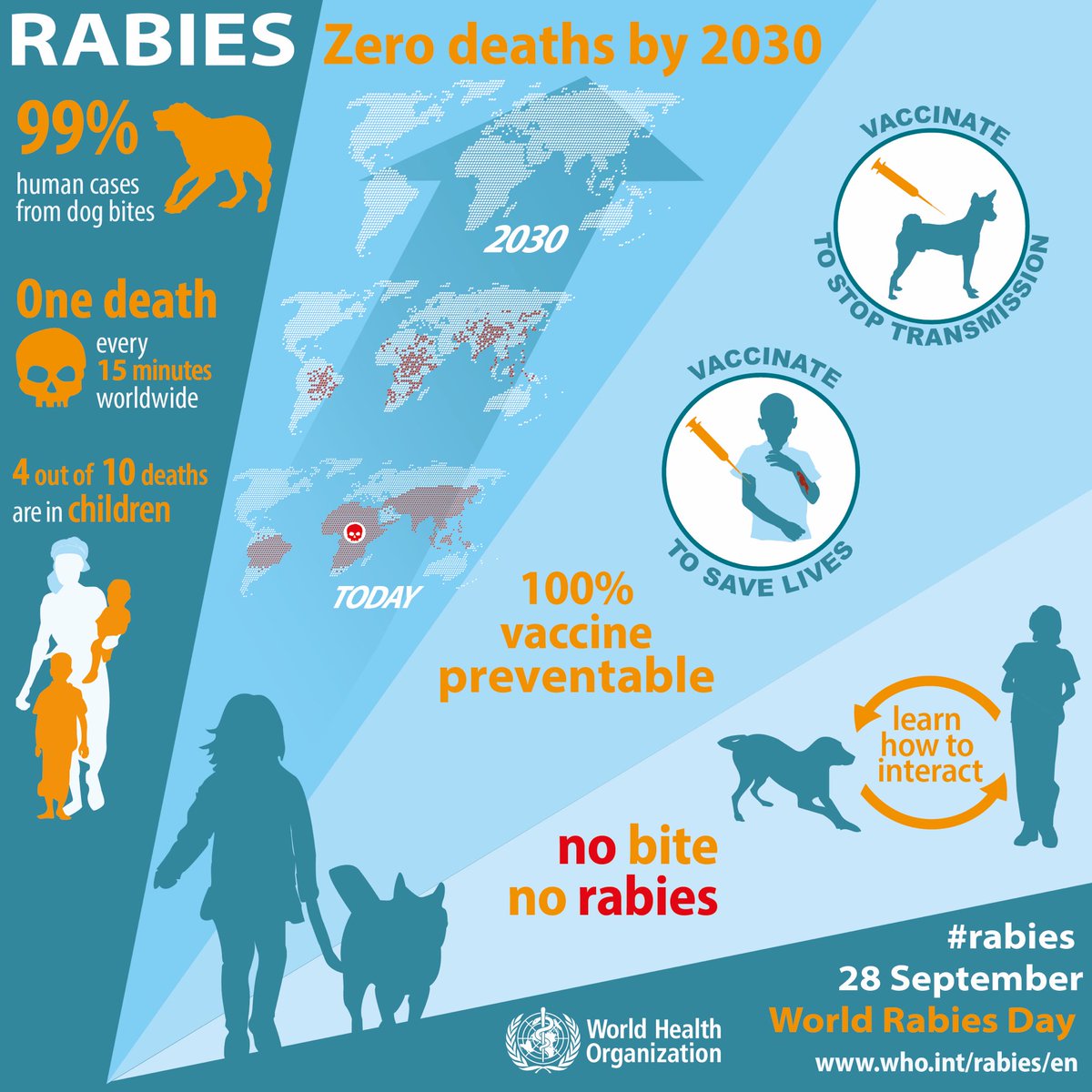 Alive? Behaving appropriately? Then the vaccinations are canceled.
Alive? Behaving appropriately? Then the vaccinations are canceled.
In the event that there is a threat of rapid development of the disease, the patient is injected with anti-rabies (anti-rabies) immunoglobulin – it is important to do this within the first days after the bite.
Rabies vaccinations are given in any emergency room. For children – in the thigh, for adults – under the shoulder blade. The effectiveness of the vaccine is 98%, but on condition that it was started no later than two weeks after the bite.After vaccination, the first antibodies to the virus appear after 14 days, and they reach their maximum concentration after 30 days.
There are no contraindications for the administration of the vaccine – vaccinations are given to pregnant women and people with acute pathologies. And the side effects of COCAVs are minimal – only 0.03% of patients develop allergies. At the vaccination site, swelling and pain may appear, sometimes the temperature rises to 38 ° C and chills appear, there may be headaches. But this is all nonsense compared to guaranteed death, if not vaccinated.
But this is all nonsense compared to guaranteed death, if not vaccinated.
During treatment and within six months after it, it is important to follow a number of rules. It is strictly forbidden:
- to drink alcohol;
- take a steam bath and sauna;
- overcooling;
- be physically overloaded.
The immunity against rabies, formed after vaccination, is valid for a year.
And remember again, the only way to cure rabies is through vaccinations. And the sooner they begin to do them after the bite, the higher the chances of not getting sick.After the onset of symptoms, it is incurable, and the mortality rate is 100%. 90,028 90,030 90,000 symptoms, first signs, prevention and vaccination
What is rabies and what is the danger of this disease?
Rabies is an acute infectious disease of warm-blooded animals and humans, usually with a fatal outcome.
The disease is caused by the Rabies virus, which affects the brain, causing irreversible changes in it.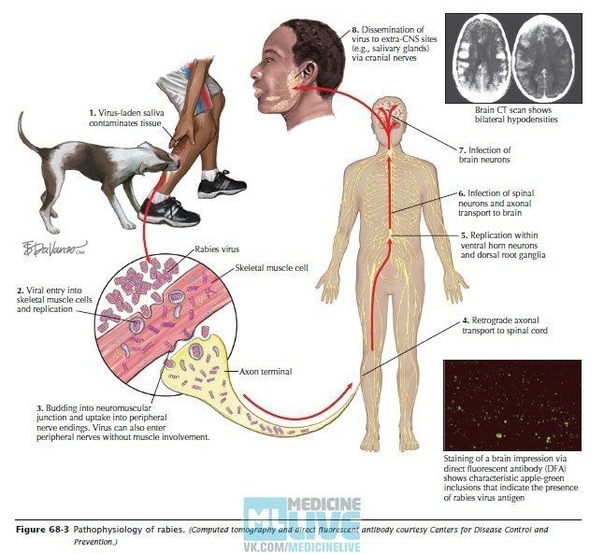
Rabies is registered in almost all countries – according to the World Health Organization, more than 55,000 people die from rabies every year.
This disease has been known since ancient times, and although it was described as early as the 5th century BC, by 2005 only three documented cases of recovery were known.
In 2005, a successful cure for rabies was reported in the United States for the first time – a group of American doctors developed an experimental treatment called the Milwaukee Protocol, and Gina Gees, a bat-bitten girl, who received this treatment, recovered.
Subsequently, this technique was used in different countries in the treatment of another 35 people who fell ill with rabies, but of them only 4 people recovered.
According to experts, the effectiveness of treatment according to the Milwaukee Protocol has not been fully proven, and in general the effectiveness of this method is recognized as no more than 20%, moreover, this method is still experimental and very expensive.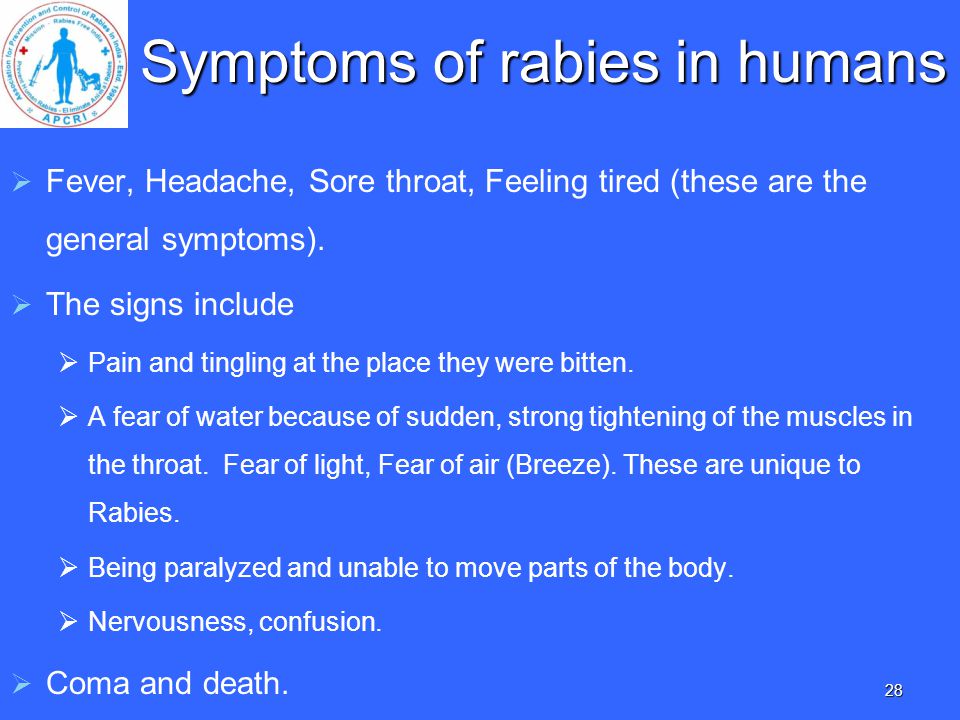
That is why, at the moment, rabies is considered to be an incurable disease with almost 100% fatal outcome.
Many residents of large cities mistakenly think that this danger does not concern them. Unfortunately, this is not at all the case – according to Rospotrebnadzor, the epizootic situation in Moscow due to rabies is constantly tense.This is due to the fact that there are many active natural foci of rabies around the capital. So, only in 2013-2016, about 50 cases of this disease in animals were registered in Moscow, and according to the Rosselkhoznadzor, only for the period from February 1 to February 18, 2016, 166 cases of rabies were recorded in Russia.
Which animals can get rabies?
Rabies can affect all mammals and birds. The main reservoir of rabies in nature is wild predatory animals – foxes, wolves, raccoon dogs; there is also a hypothesis that rodents are the natural reservoir of the virus.Less often bears, lynxes, moose are ill.
For our region, foxes and hedgehogs are the most dangerous.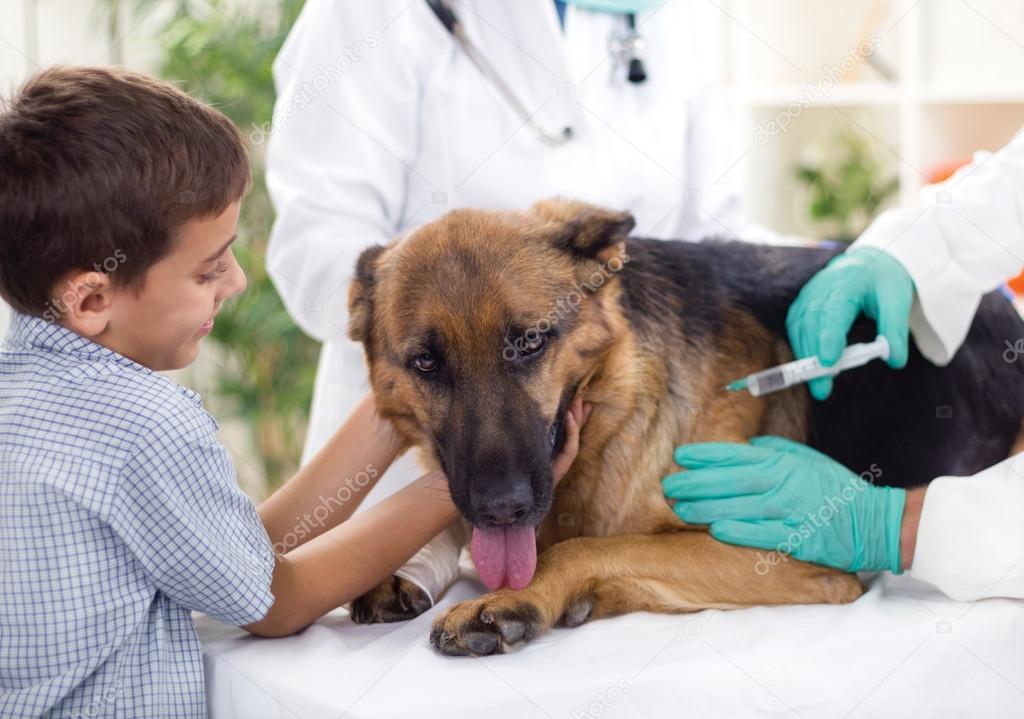
How do you get rabies?
Infection of a person or a pet occurs when a sick animal bites or when infected saliva comes into contact with damaged skin or mucous membranes. Dangerous contact not only with a “rabid” animal, but also with an animal carrier. The virus in saliva is detected 8-10 days before the manifestation of obvious clinical signs of the disease.
One of the most common routes of infection is when unvaccinated dogs are taken out into the countryside, where they attack infected hedgehogs.
Not only “summer residents” are at risk, but also those who are never taken out of the city. After all, about 800 wild foxes live on the territory of Moscow, as well as hedgehogs, rodents and other representatives of the fauna that your pet may encounter not only in the park, but also just walking in the yard.
Incubation period
The incubation period (the latent period from the moment the virus enters the body until the manifestation of signs of the disease) lasts from 9 days to several months and depends on the virulence (strength) and the amount of the virus that entered the body, the site of the bite, the age of the animal, and the state of its immune system.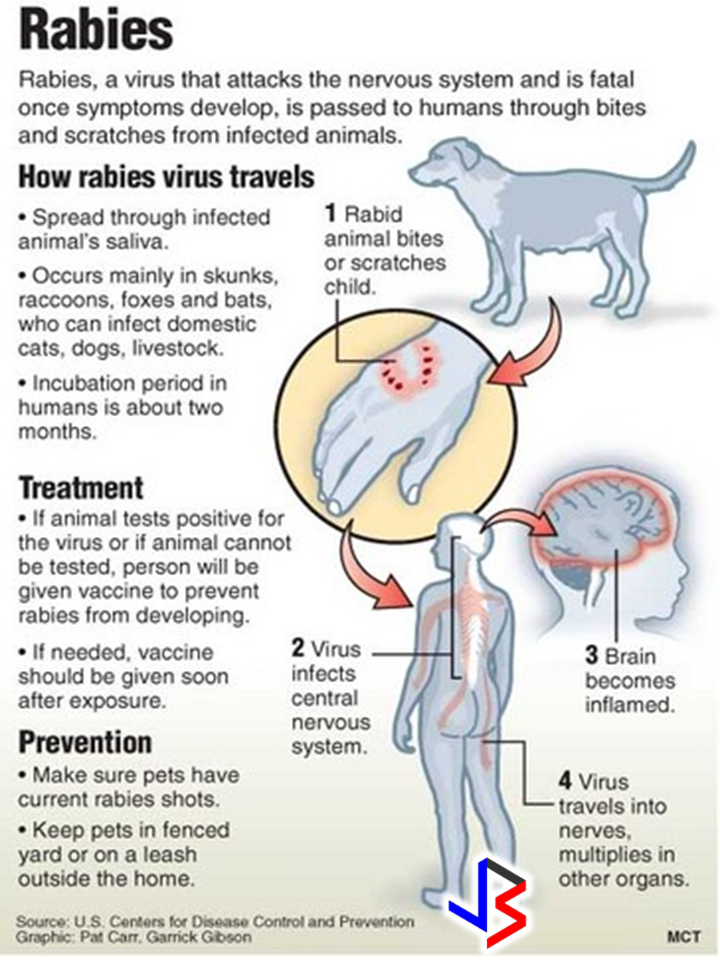 Usually, clinical signs appear 15-25 days after infection.
Usually, clinical signs appear 15-25 days after infection.
The deeper and more extensive the wound, the more the virus could get into it with saliva. And the more rich in nerve endings the bite site is, the faster the disease manifests itself, since the virus enters the brain through nerve fibers.
The most dangerous bites are in the head and hands, since there are a significant number of nerves, and the path of the virus to the brain is shorter, and the incubation period is accordingly shorter.
Once in the body, the virus fixes itself on the nerve cells, begins to multiply and moves along the nerve trunks in the spinal cord and further into the brain. The virus can also spread through the bloodstream, as evidenced by infection of fetuses in pregnant animals with rabies.
The multiplied virus enters the salivary glands along the nerve fibers and is excreted with saliva, and it has been established that the virus is detected in saliva 8-10 days before the first clinical signs appear, which is why preventive measures after a bite should be started as early as possible.
How does the disease manifest itself?
Different animal species may exhibit different clinical signs of rabies. Dogs usually do not have hydrophobia. Most often, cats have a violent form of rabies – they become aggressive towards people and other animals, tend to run away from home and die within 3-6 days. But foxes, on the contrary, often lose their caution, cease to be afraid of a person, reach out to people and behave like tame.
Remember that if a wild animal does not run away from a person and behaves in an unusual way, you can suspect that it is sick with rabies.
Dogs exhibit the most typical rabies symptoms. It is customary to distinguish five forms of the disease:
- Violent – lasts 6-11 days and passes in three stages, turning one into another. In the first, prodromal or melancholic, minor changes in behavior appear, the dog becomes apathetic, avoids people, hides or, on the contrary, becomes overly affectionate, its appetite worsens, swallowing may be difficult and drooling may appear.
 At this stage, the dog is already contagious.The second stage, the stage of excitement or manic, is characterized by a sharp change in behavior: the dog is aggressive, appetite perversion is often observed, the dog swallows inedible objects, sticks, stones, etc., bites people and animals that come across it, laryngeal paralysis develops; the dog is unable to eat and drink and the disease flows into the third, last, paralytic stage, which is characterized by progressive paralysis and ends with the death of the animal.
At this stage, the dog is already contagious.The second stage, the stage of excitement or manic, is characterized by a sharp change in behavior: the dog is aggressive, appetite perversion is often observed, the dog swallows inedible objects, sticks, stones, etc., bites people and animals that come across it, laryngeal paralysis develops; the dog is unable to eat and drink and the disease flows into the third, last, paralytic stage, which is characterized by progressive paralysis and ends with the death of the animal. - Silent, or paralytic – lasts 2-4 days, the dog is not aggressive, paralysis of the lower jaw, pharynx and hind limbs is expressed.
- Atypical – characteristic symptoms are not expressed, the stage of arousal is absent, exhaustion, gastroenteritis can be observed.
- Abortive, in which at the beginning of the second stage the disease suddenly stops and the animal is cured. This rare and poorly studied form of the disease accounts for only 1-2% of all cases.
- The relapsing form is characterized by the fact that after an apparent recovery, the symptoms of the disease reappear, and such alternations are observed 2-3 times at short intervals.The returnable form also ends with the death of the animal.
It is known that not all those bitten by rabid animals get sick, but do not delude yourself – this percentage is small from 1 to 8%
After the manifestation of symptoms of the disease, a person dies in 5-8, sometimes 10-12 days, the life of a sick animal is even shorter – 2-6 days.
Diagnosis and Treatment
There is no cure for rabies and sick animals are destroyed.
The final diagnosis is usually made after postmortem examination of the brain of an animal that died from the disease for the presence of Babesh-Negri bodies – cellular inclusions found in the cytoplasm of nerve cells during rabies.
If you suspect that the animal is sick with rabies, then you must notify the state veterinary service at your place of residence or the regional station for combating animal diseases, and by the decision of the veterinarian, the animal is sent to quarantine, which takes place within the established time limits in accordance with the sanitary and veterinary rules and regulations.
Since rabies is a particularly dangerous disease, the delivery of an animal to quarantine and subsequent quarantine is free.
Restrictive measures are imposed on areas that are unsafe for rabies – dogs and cats cannot be taken out, exhibitions, etc.
The restrictions are lifted 2 months after the last case of the disease.
Prevention. How to protect your pet?
The only remedy that can protect your pet from rabies disease is timely vaccination.
Vaccination is no longer effective when clinical signs of the disease appear.
In our country, only inactivated rabies vaccines are allowed for use, such vaccines do not contain live viruses, therefore, the disease of an animal with rabies as a result of the use of such a vaccine, contrary to common “horror stories”, is, in principle, impossible.
At present, there are quite a large number of rabies vaccines, both domestic and foreign. They are both monovalent – only against rabies, and polyvalent (complex), protecting against rabies and a number of other diseases.All rabies vaccines are highly effective, the doctor will advise which vaccine is best for your pet.
90,029 Dogs and cats are routinely vaccinated from 12 weeks of age. However, if there is a real threat of disease, the animal can be vaccinated earlier than the specified age, with repeated vaccination after reaching 3 or 6 months.
Subsequent revaccination is carried out annually. Immunity after vaccination is formed in 3-4 weeks.
Adverse reactions of the body to the administration of the rabies vaccine are possible, but fortunately, they are quite rare and in this case the benefits of the vaccine are many times greater than the risks.
Despite the fact that the instructions for some imported vaccines indicate the possible terms of revaccination against rabies in 2-3 years, according to the legislation of our country, it is necessary to vaccinate animals annually, otherwise problems may arise when the animal is exported abroad, or if your dog is -or bite.
Only a clinically healthy animal can be vaccinated; 10-14 days before vaccination, deworming must be carried out.
It is necessary to vaccinate animals against rabies only in licensed veterinary clinics, since only in this case you will receive the necessary vaccination documents.
During the initial vaccination, a veterinary passport is issued for an animal, indicating the timing of vaccinations, the name and series of the introduced vaccine; in the future, information about subsequent vaccinations is also entered there. This is a necessary document for any trips with a dog, visiting exhibitions, it is on the basis of a veterinary passport that an animal is issued a certificate No. 1 for transporting animals in public land and air transport.
To receive a certificate of form No. 1, the animal must be vaccinated against rabies at least 30 days before the planned date of departure, but not more than one year.
This certificate is valid for 5 days.
In accordance with the law of the Russian Federation and the rules for keeping dogs and cats, all these animals must have a veterinary passport with notes on all the necessary vaccinations, and regardless of whether they are taken out somewhere or simply kept at home.
What if you or your dog / cat are bitten?
Any bites from wild animals should be perceived as potentially dangerous due to rabies.
The most important thing that needs to be done immediately after the bite is immediately or as soon as possible to thoroughly wash the wound with soap and water, which kills the virus, destroying its shell and treat with 40-70 degree alcohol or iodine solution; then you should URGENTLY contact the veterinary clinic.
People who have been bitten by suspicious rabies or unknown animals are also immediately treated for the wound; they urgently need to contact the nearest emergency room for further treatment and preventive measures.
If the owner of a bitten dog or cat cannot provide a vaccination certificate, then the dog is subject to quarantine (usually at home) for 10 days, and if during this time the animal does not show symptoms of rabies, then it is considered healthy.
Elena Filina
Without noise and foam: how to protect yourself from rabies | Articles
With the beginning of the warm season, the risk of the spread of rabies increases: an increase in the activity of wild animals, as well as an increase in the number of people who go out of town, including with pets, is affected. The disease itself is fatal and incurable, including for humans. Earlier, Rospotrebnadzor warned that in some regions of Russia the situation remains difficult. This spring rabies was also on the radar against the backdrop of a scandal in Yakutsk, where over a hundred animals were euthanized in a city shelter due to suspicion of the disease. How to identify a sick animal, why foam is an important but optional sign, what to do when meeting with it and how to protect yourself and your pets – in the material of Izvestia.
Absolutely fatal disease
Rabies is an acute infectious disease that affects the nervous system and is fatal in both humans and animals.The latter are its carriers, it is from them that a person can become infected, including through pets that have not been vaccinated.
According to the World Health Organization, the disease occurs in more than 150 countries around the world and is present on all continents except Antarctica. Every year it causes the death of tens of thousands of people (according to the latest WHO estimates, published, however, back in 2017, it was about 60 thousand people).
Most deaths occur in countries in Africa and Asia, but deaths in humans occur in other countries. In Russia, according to Rospotrebnadzor, from 2012 to the end of summer 2019, 30 such cases were recorded. At the same time, the department emphasized that the situation with this disease in the country is difficult.
Photo: RIA Novosti / Alexey Danichev
“In recent years, in most territories of the Russian Federation, there has been a deterioration in the epizootic situation due to rabies; new foci appear in the wild; the population of stray dogs and cats in settlements is increasing.(…) Due to the fact that an unfavorable epizootic situation of rabies has been observed in the country over the past decades, the danger of human infection remains extremely high, ”the ministry said in a statement.
Earlier, Rospotrebnadzor reminded that rabies is “an absolutely fatal disease that ends in death in 100% of cases.” In total, 400-450 thousand people suffer annually from animal attacks in the country, in anti-rabies treatment, that is, vaccination, then about half of them need.90,030 90,029 According to WHO, children under the age of 15 are at risk – according to the organization, by 2018, they accounted for up to 40% of bites.
Although the world really does not know how to treat the disease itself, preventive measures can successfully reduce the likelihood of the disease, so it all depends on how quickly a person see a doctor after contact with an animal that could be a carrier of the disease.
The risk of contracting rabies increases with the onset of warm weather, when wild animals become more active and people travel outside the city – including with free-range pets.
There are also measures to prevent disease among wild animals – these are, first of all, special edible vaccines that are spread in the forest. However, such measures are often insufficient or untimely, Pavel Rakhmanin, Ph.D. in veterinary science, director of the Institute of Biotechnology of Veterinary Medicine, explained to Izvestia.
Photo: Depositphotos
– We do not always allocate funds for the vaccination of wild animals against rabies.Or it happens that funds are allocated, but not when they are needed – this is spring and autumn, when there is no snow, and the temperature is not too hot, – said the source of the publication.
This year, since mid-February, the distribution of special vaccines began in certain regions, including in hunting farms of the Vladimir region, since March – in the Nizhny Novgorod region and the Amur region.
Such prevention reduces the likelihood of spreading the disease, but does not guarantee protection for humans, since it is not possible to track which animals have eaten the vaccine.That is, for any contact with wild animals that may be carriers of infection, you will still need to consult a doctor.
How to identify the vector
One of the key recommendations of specialists is to avoid contact with stray, unvaccinated or wild animals.
Humans are most often infected with rabies from dogs – according to the WHO, they account for up to 90% of cases. According to other sources, in Russia – about 60% of cases.
But the main vectors are not really dogs, but wild animals. It should be borne in mind that the disease is more common in representatives of certain species, which are considered the most likely distributors.
Statistics by country may vary, but in Russia are primarily foxes, raccoon dogs, sometimes rodents or hedgehogs . Rospotrebnadzor also indicates that wolves can sometimes carry the disease . However, it is possible that representatives of other species with which rabies are not usually associated, for example, cattle, become sick with rabies after contact with infected animals.
In 2019, in particular, the department noted an increase in the number of sick farm animals in the Moscow, Tver, Ryazan, Kursk, Bryansk, Chelyabinsk, Sverdlovsk, Voronezh, Lipetsk regions, in the Krasnoyarsk Territory and Buryatia.
The virus affects the nervous system, so the main reason to be alert is the non-standard behavior of the animal , Veronika Matyushina, founder of the Phoenix Wildlife Rehabilitation Center, told Izvestia.
Photo: RIA Novosti / Ilya Pitalev
– If a wild animal, especially one that is a frequent carrier, comes out to people or on the track, behaves inappropriately – too affectionate or too aggressive – this is already a serious sign. Such animals can, for example, bite objects indiscriminately, because at this moment they no longer control their behavior, – said the interlocutor of the publication.
Refusal of food can indicate the presence of rabies – for example, when people try to feed an animal that has come to the site, and, most importantly, water (the disease is also known as hydrophobia or hydrophobia).
One of the most famous signs of the disease is the presence of foam on the animal’s face. But in reality, it will not necessarily be present.
– Foam occurs already in the final stages, when the animal dies. You need to pay attention, including to faded coat or a stopped gaze, – explains Veronika Matyushina.
Some animals, including pets, may also show paralysis.
When meeting such an animal, you must not come close to it or try to drive it away .On the contrary, you need to exclude any contact, and then contact the veterinary services. After that, the animal can be killed or euthanized in the presence of the district police officer, who will draw up protocol . Then the animal’s head should be taken for examination – despite the presence of symptoms, the final rabies can only be confirmed on the basis of an analysis of its brain.
It was precisely the desire to eliminate a possible focus of the disease that the Yakutsk authorities explained in early March that about 200 animals were killed in the city shelter.
But in some cases, if we are not talking about the terminal stage, the symptoms in animals may coincide with the symptoms of other treatable diseases . Then the specialists can euthanize him and place him in quarantine for observation.
The problem, however, is that there are practically no suitable quarantine premises in Russia, especially at the district level, so this practice is almost never used.
Reaction speed
The virus is transmitted through saliva, so a bite is enough for infection (bites on the head or hands are considered especially dangerous) and simply getting saliva on the skin, where there may be an open wound.It is possible to stop the development of the disease thanks to the introduction of the vaccine and the treatment of the wound, therefore, in this case, the speed with which a person turns to doctors for help plays a decisive role.
The disease may not appear immediately, but in the period from a week to one year. Most often, we are talking about several months.
“Initial symptoms of rabies include fever and pain, and unusual or unexplained tingling, tingling, or burning (paresthesia) sensations at the wound site.As the virus spreads through the central nervous system, progressive fatal inflammation of the brain and spinal cord develops, ”the WHO website says.
As the virus spreads through the central nervous system, symptoms such as fear of hydration, aerophobia may also appear, in some cases, rabies leads to gradual paralysis.
Photo: Depositphotos
It is important to understand that from the moment the disease manifests itself, it will be impossible to cope with it.On average, the course of the disease takes about ten days, after which death occurs.
– If there is a possibility of infection, then a person has a day, a maximum of two, to prevent the possible development of the disease. You must immediately contact the doctors who will vaccinate you, ”recalls Veronika Matyushina.
At the same time precautions must be taken even if the animal looks healthy, but has not been vaccinated against rabies or nothing is known about it .
– Carriage of viruses can be long-term, it depends on the species characteristics of the animal and on the place where it was bitten. If possible, such animals should be quarantined for observation, – says Pavel Rakhmanin.
The World Health Organization recommends to start by immediately washing the wound thoroughly with soap and disinfecting it – even before the so-called post-exposure prophylaxis (administration of a vaccine or a course of vaccines after a bite).
Rospotrebnadzor reminds that in Russia rabies vaccination is done free of charge if you have a policy of compulsory medical insurance . In some cases, it is also done in advance for preventive purposes – if human activities are associated with increased risks of infection.
Annual vaccine
Although developed rabies is incurable in either humans or animals, preventive measures are considered to be very effective .
That is why pets need to be vaccinated annually , preferably before the start of the warm season, experts remind.
– We have many animals self-walking. In this case, it is almost impossible to trace the possible moment of infection. If the cat has gone outside, he will not tell you who he fought with. The same applies to cattle – a cow can become infected in the field and become a carrier of the virus, explains Veronika Matyushina.
Photo: Global Look Press / Nicolas Armer
The owner or other occupants of the home may simply not know that they have contracted rabies until it is too late to treat the disease.Moreover, if revaccination is carried out every year and performed by a competent specialist, then its action will be enough even with a strong bite from an infected animal, Pavel Rakhmanin points out.
At the first signs of a disease in a pet, you must immediately contact the veterinarian, without trying to self-medicate, remind in Rospotrebnadzor.
If the animal has not been vaccinated, but has come into contact with a wild or street animal, you must immediately contact the veterinary station, where he will be vaccinated and possibly quarantined for observation.
READ ALSO
10 myths about rabies / Habr
Hello everyone.
A little over a year ago, I had to deal with such an unpleasant thing as the suspicion of being infected with rabies. An article I read yesterday on vaccinations for travelers reminded me of that incident – especially the lack of mention of rabies in it, although it is an extremely widespread (especially in Russia, Asia, Africa and America) and very insidious virus. Unfortunately, the risks associated with it are not always given due importance.
So what is rabies? It is an incurable viral disease that is transmitted through the saliva or blood of infected animals and people. In the overwhelming majority of cases, the bite of an animal carrying the virus leads to infection.
What can the average Russian citizen say about rabies? Well, there is such a disease. In connection with it, mad dogs are most often remembered. The older generation will most likely add that in the event of a bite from such a dog, you will have to do 40 injections in the stomach and forget about alcohol for several months.That’s probably all.
Let’s see why such an attitude towards this disease is extremely dangerous.
Surprisingly, not everyone knows that rabies is a 100% fatal disease. If the virus has entered your body in one way or another, a “countdown” is activated: gradually multiplying and spreading, the virus moves along the nerve fibers to the spinal cord and brain. His “journey” can last from several days or weeks to several months – the closer the bite is to the head, the less time you are given.All the while, you will feel completely normal, but if you allow the virus to reach its target, you are doomed. When this happens, you will not yet feel the symptoms of the disease, but you will already become a carrier: the virus will appear in the body’s secretions. After that, rabies becomes possible to detect by means of tests, but it is too late to treat it at this stage. As the virus multiplies in the brain, initially harmless first symptoms begin to appear, which within a few days develop into rapidly progressive inflammation of the brain and paralysis.The outcome is always the same – death.
Rabies treatment is literally a race to death. The disease will not develop only if, before the virus enters the brain, you have time to apply the rabies vaccine and give it time to take effect. This vaccine is an inactivated (dead) rabies virus that is injected into the body to “train” the immune system to fight the active virus. Unfortunately, this “learning” takes time to generate antibodies, while the virus continues to make its way to your brain.It is believed that it is not too late to apply the vaccine up to 14 days after the bite – but it is better to do it as early as possible, preferably on the very first day. If you asked for help in a timely manner and you were given a vaccine, the body will form an immune response and destroy the virus “on the march”. If you hesitated and the virus managed to penetrate the brain before the formation of the immune response, you can look for a place for yourself in the cemetery. The further development of the disease will no longer be stopped.
As you can see, this disease is extremely serious – and all the more strange are the myths on this topic that exist in Russia.
Myth number 1 : Only dogs can carry rabies. Sometimes cats and (less often) foxes are also called as possible carriers.
The sad reality is that besides the named ones, rabies carriers can be many other animals (more precisely, mammals and some birds) – raccoons, cattle, rats, bats, roosters, monkeys, jackals, and even squirrels or hedgehogs.
Myth number 2 : a rabid animal is easy to distinguish by inappropriate behavior (the animal moves strangely, it saliva flows, it rushes at people).
Unfortunately, this is not always true. The incubation period of rabies is quite long, and the saliva of the carrier of the infection becomes infectious 3-5 days before the first symptoms appear. In addition, rabies can proceed in a “quiet” form, and the animal often loses fear and goes out to people, outwardly showing no threatening symptoms. Therefore, if any wild or simply unknown animal is bitten (even if it looked healthy), the only correct action is to consult a doctor as soon as possible, preferably on the very first day, to administer the rabies vaccine.
Myth number 3 : if the bite wound is small, just wash it with soap and disinfect it.
Perhaps the most dangerous delusion. The rabies virus, indeed, does not tolerate contact with alkaline solutions – but any damage to the skin will be enough for it to penetrate the tissues of the body. There is no way to know if he had time to do this before washing the wound.
Myth number 4 : the doctor will definitely prescribe you 40 painful injections in the abdomen, and you will have to go to these injections every day.
It really was so, but in the last century. Currently used rabies vaccines require 4 to 6 shots to the shoulder at intervals of several days, plus the option of another shot to the bite site.
In addition, a doctor (infectious disease specialist or rabiologist) may decide on the inappropriateness of vaccination, based on the circumstances of the bite and the local epidemiological situation (it is estimated what kind of animal it was, domestic or wild, where and how everything happened, whether it was cases of rabies were recorded in the area, and so on).
Myth number 5 : Rabies vaccination has many side effects and can even cause death.
There are indeed side effects for this type of vaccine – this is the main reason why in most cases rabies is not vaccinated prophylactically, but only if there is a risk of infection. These “side effects” are rather unpleasant, but more often than not they are not very long-lasting, and to endure them is not such a big price to stay alive. It is impossible to die from the vaccinations themselves, but if, after the bite of a suspicious animal, they are not done or the repeated vaccination is skipped, then you can very much even die of rabies.
Myth number 6 : if you catch or kill an animal that has bitten you, then you do not need to be vaccinated, because doctors can do an analysis and find out if it was sick with rabies.
This is only half true. If the animal is caught and does not show signs of rabies, it can be quarantined, but this will not save you from vaccination. Doctors can make the decision to stop it only if the animal does not get sick and dies within 10 days – but here you can be trapped by such a trap as atypical rabies.This is when a sick animal lives significantly longer than those same 10 days – and all this time it is a carrier of the virus, without showing external symptoms of the disease. Comments are superfluous. However, it should be noted that statistically atypical rabies is extremely rare – but it is still better to complete the initiated vaccination course than to get into the very statistics and prove later in the next world that a tragic coincidence has occurred.
In the case when the animal is killed on the spot or caught and euthanized – such an analysis is possible through the study of brain slices, but how long it will be done (and whether they will) very much depends on where everything happened and where you went for help.In most cases, it is safer to immediately start the vaccination course and stop it if rabies is not confirmed by laboratory tests.
If the animal that bit you escaped, this is an unambiguous indication for vaccination, and only a doctor should assess the degree of risk here. Of course, taking a course of vaccinations may well turn out to be a reassurance – after all, you have nowhere to find out for sure whether the animal was infected with rabies. But if the vaccination is not done, and the animal was still a carrier of the virus, then you are guaranteed a painful death in a few weeks or months.
Myth number 7 : If you have been bitten by an animal that has a rabies vaccine, no vaccination is required.
This is true, but not always. The vaccination must be, firstly, documented (recorded in the vaccination certificate), and secondly, it must not be overdue or delivered less than a month before the incident. In addition, even if according to the documents everything is fine, but the animal behaves inadequately, you should consult a doctor and follow his recommendations.
Myth number 8 : You can get rabies if you touch a sick animal, or if it scratches or licks you.
This is not entirely true. The rabies virus is not able to exist in the external environment, therefore, it cannot be on the skin / hair of an animal or on the claws (for example, of a cat). In saliva, he feels great – but he is not able to penetrate through intact skin. In the latter case, however, you should immediately wash with soap and disinfect the slobbed skin area, after which you should still consult a doctor and let him decide on the need for further action.
Myth number 9 : during and after vaccination against rabies, alcohol should not be consumed, otherwise it will neutralize the effect of the vaccine.
There is no scientific basis for claims of alcohol blocking antibody production during rabies vaccination. Such a horror story is common only in the countries of the former USSR. Tellingly, outside the former socialist camp, doctors have not heard of such prohibitions, and there are no alcohol-related contraindications in the instructions for rabies vaccines.
The roots of this horror story go back to the last century, when vaccines of the previous generation were used, which actually injected in the stomach for 30-40 days in a row. Skipping the next injection, both in those days and now, is fraught with nullifying the effect of vaccination, and drunkenness is one of the most common reasons for not showing up to the doctor.
Myth number 10 : Rabies is curable. The Americans cured the sick girl according to the Milwaukee Protocol after the onset of symptoms of the disease.
This is very controversial.Indeed, such an extremely complex and expensive (about $ 800,000) method of treating rabies at the stage of symptom onset exists, but a few cases of its successful use have been confirmed worldwide. In addition, science still cannot explain exactly how they differ from the much larger number of cases when treatment using this protocol did not bring results. Therefore, you should not rely on the Milwaukee Protocol – the probability of success there hovers at the level of 5%. The only officially recognized and effective way to avoid rabies in case of risk of infection is still only timely vaccination.
In conclusion, I will tell you an instructive story. I live in Germany, and we, like in many neighboring countries, have no “local” rabies in animals (and therefore cases of human infection) for a long time thanks to the efforts of the government and health organizations. But the “imported” sometimes seeps through. The last case was about 8 years ago: a man was admitted to the hospital with complaints of high fever, cramps when swallowing and problems with coordination of movements. In the course of collecting the anamnesis, he mentioned that 3 months before the onset of the disease, he returned from a trip to Africa.He was immediately tested for rabies – and the result was positive. The patient later managed to tell that he was bitten by a dog during the trip, but he did not attach any importance to this and did not go anywhere. This man soon died in an isolated ward. And all the local epidemiological services, up to the Ministry of Health, were already on their ears by that time – still, the first case of rabies in the country for hell knows how many years … They did a titanic job, within 3 days finding and vaccinating everyone with whom the deceased had contact after returning from that ill-fated trip.
Do not neglect animal bites, even pets, if they are not vaccinated – especially in countries where rabies is common. Only a doctor can make a competent decision on the need for vaccination in each specific case. By letting it go, you put your life and the lives of your loved ones at risk.
Prevention of rabies
REMINDER on measures to prevent rabies
(for the population)
RABIES is an acute viral infectious disease common to humans and animals, characterized by severe lesions of the nervous system.
In the presence of clinical manifestations in a person, the disease ends in death.
Animals are the source of human infection. From domestic animals, the source of human infection is most often dogs and cats, from wild animals – foxes, wolves, raccoon dogs and various rodents.
Human infection occurs through bites, scratching, saliva from sick animals, as well as through contact with objects contaminated with the infected saliva of a sick animal.
If your animal has bitten a person, do not run away, but tell the victim your address and deliver the dog or cat for examination and observation by the veterinarian at the veterinary station. The owner of the animal bears full administrative, and in case of serious injury and death of the victim – criminal liability for violation of the “Rules for keeping animals”.
Pets must be vaccinated against rabies and have a certificate of immunization.
Human rabies can only be prevented by prophylactic vaccinations, the effectiveness of which depends on the period of seeking medical help.
In order to prevent rabies, all victims of animal bites, scratching and salivation and for a course of anti-rabies vaccinations should immediately seek medical help at the trauma center at their place of residence.
Attention! Vaccinations against rabies for people are free of charge, regardless of the presence of a compulsory health insurance policy.
In medical practice, a vaccine is used that practically does not give complications and produces a high level of immunity.The course of vaccinations can be from 3 to 6 injections, depending on the nature of the damage and the health of the animal.
Remember that only timely vaccinations against rabies can prevent rabies disease!
How to behave if you are bitten by a dog.
Rabies prevention
The economic crisis has affected not only Russian citizens, but also their best friends – dogs. The population of stray dogs on the streets of cities has increased dramatically recently.Hence the behavior of many stray dogs is clear, because everyone knows: “a dog is biting only from the life of a dog.” In addition, recently it has become fashionable to get aggressive breeds of dogs – fighting and guard dogs. Such dogs, being in narrow apartments all day long, are exposed to all sorts of stresses and therefore at any moment they can react inadequately to those around them. Flocks of stray street dogs are especially dangerous in spring and autumn. At this time of the year, dogs are seething with hormones and animals strive to demonstrate their strength and attack anything that moves.If you come across a flock of stray dogs, in no case run without losing sight of the dogs, calmly leave the place. When a person runs in dogs, the hunter’s reflex is triggered and then a bite cannot be avoided. Also try not to anger the bitch with puppies and beware of her attack. Her maternal instinct forces her to protect her offspring, so when she meets her, leave without sudden movements, but just don’t run. Go around the territory protected by dogs, if you entered this territory, then do not run, but call the owner of the dog.In no case should the dog be frightened, shouted at it and waving its arms or hitting it. Never look your dog directly in the eye, as dogs accept this as a challenge to attack. If the dog nevertheless attacked you, then do not try to grab your hand, but rather push it deeper into the mouth and then the dog will loosen its grip. Usually dogs bite the wrist, shins and feet. Dogs have two canines on the upper and lower jaws, which, when bitten, cause the most serious and severe injuries. Therefore, a dog bite can damage tendons, nerves and blood vessels, and sometimes bones.Dog bites are very painful and can traumatize a person both physically and psychologically. But the main danger in such a situation is rabies.
Even a minor dog bite is a reason for an immediate appeal to a medical institution, because if a predator is infected with a rabies virus, then it is transmitted from a sick animal to a person.
The incubation period of the disease in humans takes from 10 days to 7 months.
The main symptom of rabies in dogs is profuse salivation.The susceptibility of people to rabies is different and is determined by the general condition of the person, his immunity and the site of the bite. From several hours to several days, the virus is located at the site of the bite, and then rapidly begins to spread through the nerve cells and reaches the central nervous system. Therefore, persons are dangerous to bite places close to the brain, this is the face, neck and chest.
After a dog bite, immediately wash the wound with warm water and laundry soap to inactivate the rabies virus.If there is a first aid kit nearby, then the wound can be treated with hydrogen peroxide. It is not recommended to stop the bleeding, but rather try to squeeze out more blood in order to wash out the dog saliva that has gotten into the wound, which may contain an infection, along with the blood. Then treat the skin around the wound with iodine and bandage with a sterile bandage. Go to the health center immediately for the necessary assistance. If the bite is very strong and you cannot get to the hospital on your own, call an ambulance.
At the emergency room, tell the doctor the following information – a description of the animal, its behavior, appearance, the presence of a collar, the place and circumstance of the bite. If you do not know the dog well and do not have information about its health, then the doctor prescribes a course of vaccinations against rabies.
Avoid drinking alcohol during vaccination and for six months thereafter. Also, during vaccinations, you should not overwork, overheat and hypothermia. If you know the owner of the dog, then you can refuse vaccinations and demand from the owner a certificate that the dog has been vaccinated against rabies.
Information for the population !!!
Victims of bites, scratches, salivation by animals in the settlement of Searchers should immediately contact the surgical office at the GBUZ NAO “CRP ZR NAO” at the address: st. Gubkina, 13; in the city of Naryan-Mar – in the emergency room of the GBUZ NAO “NOB” – Pyrerka street 13a.
REMEMBER THAT THE DISEASE CANNOT BE Cured, BUT PREVENTED!
RABIES is an acute viral infectious disease common to humans and animals, characterized by severe lesions of the nervous system.In the presence of clinical manifestations in a person, the disease ends in death. Animals are the source of infection for humans. From domestic animals, the source of human infection is most often dogs and cats, from wild animals – foxes, wolves, raccoon dogs and various rodents. Human infection occurs through bites, scratching, salivation by sick animals, as well as through contact with objects contaminated with the infected saliva of a sick animal.
The reasons why pets become infected with rabies, experts unanimously call the negligence of their owners, who do not vaccinate their pets on time, and even let them go for a walk without the owner’s accompaniment.Veterinarians remind that puppies need to be vaccinated from two months of age, this is one of the guarantees that the dog will be protected from a dangerous disease.
The problem of the spread of rabies in Naryan-Mar is most depressingly superimposed on another well-known urban attack – the abundance of stray dogs, both pack and “conditionally master” – those dogs who proudly rush through the streets alone, but with a collar worn by well-wishers not thinking about the danger to everyone else.Under conditions of rabies quarantine, there is hope that the district and city authorities will take an effective and legal solution to this problem, without leading to a case similar to the sensational death of a child in Arkhangelsk.
RABIES is a viral zoonotic disease affecting domestic and wild animals. The carriers of the rabies virus are mainly wild animals, from which the disease is transmitted to domestic animals and humans. In North America, most reported deaths have been from the bite of a silver-haired bat.The most common ways of infecting people with rabies are the bites of infected dogs, cats, wild carnivores – foxes, raccoons, skunks, jackals, wolves, as well as insectivorous bats and vampire bats. Infected herbivores – cows, horses, deer – can transmit the virus to other animals and people, but extremely rarely. With the saliva of infected animals, through bites, scratches through damaged skin or mucous membranes, with close contact, a person becomes infected.
First symptoms : General and affecting the respiratory tract, gastrointestinal tract and central nervous system. In the acute stage of the disease, signs of hyperactivity appear – violent rabies or paralysis – silent rabies. In both cases, paralysis develops, followed by coma and death from respiratory failure. Without intensive treatment, death occurs within 7 days of the illness. Globally, 55,000 people die each year from rabies, with the vast majority of cases occurring in rural Africa and Asia.Post-exposure prophylaxis costs US $ 560 million annually.
The disease can be prevented if you know the protective measures and rules of conduct when getting bitten by animals.
To protect yourself and your loved ones, remember the following:
- In case of animal bites, as well as salivation, scratching with damage or contamination of the skin and mucous membranes, you should immediately seek medical help at your place of residence or at a medical institution at the place of temporary stay, regardless of whether you have a medical policy or an identity document – immediately .
- An effective means of protection against rabies is washing the wound or the site of contact with soap and water, detergent, or simply followed by treatment with ethanol, tincture or aqueous iodine solution.
- When prescribing a vaccination, it is necessary to strictly follow the doctor’s recommendations, to appear on the specified dates, since failure to comply with the terms leads to the interruption of vaccination due to its ineffectiveness in protecting against the disease
- If signs of illness appear, notify a healthcare professional about the case of a bite by an animal (salivation, scratching) or close contact with it.
- It is necessary to remember about the lethal outcome of the disease during the first 7 days.
- Responsibility for seeking medical care, vaccination of children in a timely manner and on time rests with adults – parents, caregivers or other adults who find themselves in this situation next to children.
- Carry out a preventive examination of pets by a veterinarian, in case of illness of an animal, exclude contact with it – ironing, etc.
- If an animal is suspected of having rabies, isolate from other animals.Notify Veterinary Services.
Rabies is dangerous!
Rabies is an acute infectious disease of animals and humans caused by a virus that attacks the central nervous system and is always fatal.
Who can get rabies?
Almost all types of terrestrial mammals suffer from rabies, primarily carnivores (canine, feline, mustelids, raccoons, etc.)). Wild and domestic birds, rodents, bats can also get sick. Every year in our country, hundreds of cases of the disease are recorded among wild (foxes, raccoon dogs, wolves, etc.) and domestic (dogs, cats, cattle, horses) animals. There have been isolated cases of fatal hydrophobia among humans.
The source of rabies is a wild animal that has become infected in the natural environment, as well as a domestic animal that has been attacked by another sick animal (wild or domestic).Human infection occurs from sick animals.
How does the infection take place?
The causative agent of rabies is a specific virus contained in the saliva of a sick animal.
Human infection occurs when the saliva of a sick animal bites and penetrates the wound. Having penetrated through damaged skin, the rabies virus spreads along the nerve trunks to the brain and spinal cord. This is where the virus mainly multiplies and accumulates. Then it enters the salivary glands and is excreted with saliva into the external environment.The virus appears in saliva 1-7 days before the first clinical signs of the disease. Therefore, rabies can also be contracted by a bite inflicted on an externally healthy animal.
Infection can also occur if saliva gets on the mucous membranes of the eyes, nose, mouth, damaged skin.
Scratches caused by claws are very dangerous: animals often lick their paws, so there is enough virus on the claws for infection.
You can also get infected when cutting the carcass of a sick animal, as this often causes cuts in the fingers.The virus is unstable in the external environment, dies under normal pasteurization regimes, and instantly when boiled.
The most dangerous are bites inflicted by rabid wolves, foxes, raccoon dogs and other wild carnivores, bats. Bites of dogs and cats and kittens are somewhat less dangerous. Cases of human infection after contact with a sick farm animal (cow, horse, goat, sheep, pig) are rare. Poultry, although they can get sick with rabies, are not able to infect humans due to their lack of salivary glands.The possibility of human infection as a result of a bite inflicted by a rodent: a rabbit, a hare, a squirrel, a muskrat, a rat, a hamster, a mouse is not excluded.
Which damage is considered the most dangerous?
The period from the bite to the onset of the disease (latent or incubation period) averages 30-50 days in a person, although it can last 10-90 days, in rare cases – more than 1 year. Moreover, the farther the bite is from the head, the longer the incubation period. Consequently, taking into account the location (location) of the injury, bites to the head, face and neck are especially dangerous.The category of severe (dangerous) injuries also includes bites on the fingers, because these body parts have many nerve endings. Bites on the forearm, shoulder and trunk are considered less dangerous. The incubation period lasts the longest with a bite in the legs.
The duration of the incubation period (that is, the period preceding the onset of symptoms of the disease) in animals is from a week to several months (sometimes years), but already 5-10 days before the manifestations of the disease, the animal is infectious
A characteristic sign of animal disease in the first stage should be considered a change in behavior: an angry animal becomes affectionate, unreasonably lively, tries to lick the owner in the face; good – evil, irritable, does not go to the call of the owner, huddled in dark corners.The animal refuses its favorite food, but swallows inedible objects (wood, stones, etc.), sometimes hypersensitivity to light and noise is noted. The body temperature rises slightly. If we talk about wild animals, then for those who are sick, such a change will be the desire to make contact with a person: a healthy wild animal will never voluntarily go to a person and will run away at any attempt to get closer.
The initial stage of the disease is replaced by the second – the stage of excitement, in which the animal’s irritability increases, aggressiveness arises.An animal can attack, bite for no apparent reason.
Then comes the third, paralytic stage, very characteristic of the type of animal: the coat is disheveled, the lower jaw hangs down, the tongue falls out, saliva flows out of the mouth. On the 8-10th day, the animal dies.
What should be done when bitten by animals?
If a child or an adult is bitten, scratched, slobbering, any animal, even outwardly healthy, and even more neglected or wild, or if there is a suspicion that it is sick with rabies, you should immediately:
- intensively wash the wound with soap and water for 10-15 minutes, which will wash off the animal’s saliva.It is recommended to wash deep wounds with a stream of soapy water, for example, with a syringe. No need to cauterize wounds.
- Apply a sterile dressing to the wound. It is dangerous to suck the wound through the mouth.
- after that, in the shortest possible time, you need to contact the nearest medical institution (clinic, hospital, medical center) .If possible, it is necessary to collect as much data about the bitten animal (description of the animal, its appearance and behavior, the presence of a collar, circumstances of the bite, etc.).). If the animal is domestic (dog or cat) and is vaccinated against rabies, then you must take with you a veterinary certificate of the vaccination done or a registration certificate with a mark about the vaccination.
What will you do with the animal that bit you?
Simultaneously with a visit to a doctor about a bite, it is necessary to take measures against the bitten animal (it must be tied, isolated) and call a veterinarian for consultation. For seemingly healthy pets (dog or cat), veterinary supervision is established, the period of which is 10 days from the moment of the bite.
The sick animal is to be euthanized. It is impossible to save him. As the disease progresses, the behavior of such an animal is uncontrollable. It is important to prevent human infection.
Are there any treatments for rabies?
Unfortunately, until now, a person with rabies has not been cured. Treatment is reduced to alleviating the general condition of the patient. In this regard, it is the prevention of rabies that becomes extremely important in the fight against this disease.It includes combating sources of infection (animals with rabies) and preventing disease in humans.
What preventive measures are there?
Vaccinations remain the only reliable means of protecting people after being bitten by sick or suspected rabies animals. These include the administration of a vaccine and, if necessary, an immunoglobulin.
If you have not been bitten by an animal; for hunters, housing and communal services employees for trapping homeless animals and simply forest lovers, it is recommended to undergo a preventive vaccination course, which consists of 3 vaccinations.Apply to office 11 of the regional polyclinic in Soligorsk from 8.00 to 16.00, except Saturday and Sunday (vaccination is free).
What you need to know about preventive vaccinations:
- if the doctor has prescribed vaccinations, then they must be started immediately;
- in no case should you miss the next vaccination;
- course of vaccinations prescribed by the doctor must be completed in full;
- people who are vaccinated are not dangerous to anyone;
- during vaccinations within 6 months after their end, you should not drink alcohol, you should avoid overwork, hypothermia, overheating.
The
How to avoid being bitten, salivated by unknown animals?
Children are more likely to suffer from animal bites, therefore it is necessary to constantly educate them and try to avoid unnecessary contact with animals, especially wild and / or neglected animals:
- do not play with unfamiliar dogs, cats and other animals, it is better to keep a safe distance from them;
- should not be picked up in the country, in the forest, etc.e. wild animals. Hedgehogs and small rodents can also transmit rabies. Wrong or inadequate behavior of a child who, due to age, will not be able to assess the situation correctly, can lead to aggression by any, let alone sick animal;
- it is better not to pick up homeless stray or sick animals, but if they did, then find an opportunity to vaccinate this animal in a short time and show it to a veterinarian;
- You should not take the animal “for the summer holiday season”: throwing it away, you increase the risk of rabies in the region.It is better not to send children under 12-14 years old to walk the dog on their own, especially if it is an animal of a large and / or aggressive breed. The child may not be able to cope with it, and in the event of a non-standard situation, he will not be able to adequately explain the essence of what happened.
REMEMBER
Bites of wild animals are very dangerous. The saliva of wolves, foxes, raccoons is permeable and contains a large amount of the virus.
But you need to be attentive to pets too.
A dog and a cat are a good friend of man, but 85% of those who seek medical help for bites have suffered precisely because of improper keeping of pets. Homeless, stray and unsupervised dogs are especially dangerous. Keeping pets correctly is one of the most important conditions for preventing rabies infection.
If you notice any change in the animal’s behavior, take it to your veterinarian immediately.
Vaccinations against rabies for animals are carried out in all veterinary institutions free of charge.
Valeologist Rudenya E.N.
Rabies vaccination
Can vaccinations be waived for prophylactic (pre-exposure) rabies prophylaxis?
In accordance with the Fundamentals of the Legislation of the Russian Federation on the Protection of Citizens’ Health (Article 33) “A citizen or his legal representative has the right to refuse medical intervention or demand its termination ..”.
In accordance with the Federal Law of September 17, 1998 No.157-FZ “On immunization of infectious diseases” Article 5. Rights and obligations of citizens in the implementation of immunization:
1. Citizens in the implementation of immunization have the right to:
… refusal of preventive vaccinations.
2. Lack of preventive vaccinations entails:
- a prohibition for citizens to travel to countries in which, in accordance with international medical and sanitary rules or international treaties of the Russian Federation, specific preventive vaccinations are required;
- temporary refusal to admit citizens to educational and health institutions in the event of mass infectious diseases or the threat of epidemics;
- refusal to admit citizens to work or suspension of citizens from work, the performance of which is associated with a high risk of contracting infectious diseases.
Decree of the Government of the Russian Federation of July 15, 1999 N 825 approved a list of works, the implementation of which is associated with a high risk of contracting infectious diseases and requires mandatory preventive vaccinations:
1. Agricultural, irrigation and drainage, construction and other work on excavation and movement of soil, procurement, field, geological, prospecting, expeditionary, deratization and disinsection work in areas unfavorable for infections common to humans and animals.
2. Work on logging, clearing and landscaping of forests, health improvement and recreation areas of the population in areas unfavorable for infections common to humans and animals.
3. Work in organizations for the procurement, storage, processing of raw materials and livestock products obtained from farms unfavorable for infections common to humans and animals.
4. Work on the procurement, storage and processing of agricultural products in areas affected by infections common to humans and animals.
5. Work on the slaughter of cattle sick with infections common to humans and animals, the procurement and processing of meat and meat products obtained from it.
6. Work related to the care of animals and the maintenance of livestock facilities in livestock farms, unfavorable for infections common to humans and animals.

 This form of rabies runs a less dramatic and usually longer course than the furious form. Muscles gradually become paralysed, starting at the site of the bite or scratch. A coma slowly develops, and eventually death occurs. The paralytic form of rabies is often misdiagnosed, contributing to the under-reporting of the disease.
This form of rabies runs a less dramatic and usually longer course than the furious form. Muscles gradually become paralysed, starting at the site of the bite or scratch. A coma slowly develops, and eventually death occurs. The paralytic form of rabies is often misdiagnosed, contributing to the under-reporting of the disease. Its roll out has been disrupted due to Covid-19 WHO will continue to advise on best strategies
Its roll out has been disrupted due to Covid-19 WHO will continue to advise on best strategies
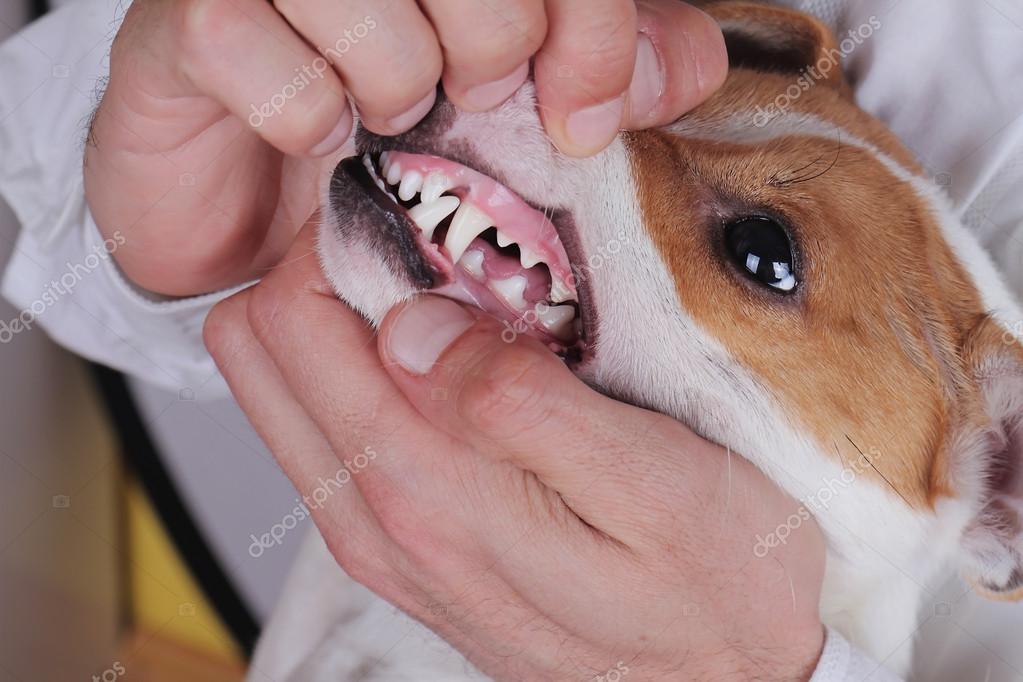 At this stage, the dog is already contagious.The second stage, the stage of excitement or manic, is characterized by a sharp change in behavior: the dog is aggressive, appetite perversion is often observed, the dog swallows inedible objects, sticks, stones, etc., bites people and animals that come across it, laryngeal paralysis develops; the dog is unable to eat and drink and the disease flows into the third, last, paralytic stage, which is characterized by progressive paralysis and ends with the death of the animal.
At this stage, the dog is already contagious.The second stage, the stage of excitement or manic, is characterized by a sharp change in behavior: the dog is aggressive, appetite perversion is often observed, the dog swallows inedible objects, sticks, stones, etc., bites people and animals that come across it, laryngeal paralysis develops; the dog is unable to eat and drink and the disease flows into the third, last, paralytic stage, which is characterized by progressive paralysis and ends with the death of the animal.